Yachting Monthly
- Digital edition


Best Liferaft for sailboats – offshore ISO9650-1 models
- July 31, 2023
Tech Editor and safety gear specialist Fox Morgan picks out some of the best liferafts for sailboats in the offshore ISO9650-1 category

We hope to never use some of the safety gear we have onboard, but that doesn’t mean we shouldn’t make some informed choices. I’ve picked out some of the best ISO9650-1 liferafts for sailboats and especially those who go further offshore or crossing oceans, racing or rallying long distances.

All of the rafts in my guide have options for canister or valise and come in sizes from 4 person to 12 person capacity. Given the size and weight of 12 man rafts, boats with full crews onboard often opt for two smaller rafts, such as 2 x 6 man to make them easier to handle and easier to stow. You can buy one and rent one too, so if most of the time there’s no more than six of you onboard but sometimes you go fully crewed, then supplementing with an additional rental raft can be a good solution. I’ve clambered aboard many liferafts in my time as a professional and corinthian sailor, getting in up that ladder has never got easier no matter how many times I practice. If you have the choice I highly recommend a raft with either a semi rigid or inflatable entrance ramp.
Ocean Safety Ocean ISO9650-1 Liferaft
Reason to buy
trusted name in the industry, variety of packs to meet all current sailing event requirements, 20 year warranty
Reasons to avoid
a premium liferaft with a premium price tag.
Specifications:
4 man liferaft
Container Dimensions (cm) 71 x 49 x 28
Container Weight (kg) 30
Valise Dimensions (cm) 67 x 42 x 24
Valise Weight (kg) 28
6 Man liferaft
Container Weight (kg) 37
Valise Dimensions (cm) 74 x 43 x 24
Valise Weight (kg) 36
4 Person Ocean Safety Ocean ISO9650-1 Liferaft <24
The Ocean Safety Ocean liferaft is made with PU Nylon Laminate. It has an insulated floor and is suitable for use in temperatures down to minus 15 degrees C. It has a less than 24 hour equipment pack as standard, but it can be upgraded to either a greater than 24 hour pack or SOLAS B.
We’ll be testing this liferaft along with others in the buyers guide in a hands on real world test this summer.
Key Features of the Ocean Safety Ocean ISO Liferaft
The less than 24 hSOLAS approved internal and external lighting system
Strong boarding ladder with knee scoop & grab handles for quick boarding Highly visible in yellow and orange Rain water collection 4/5 x 75ltr ballast pockets for increased stability (300 litres ballast for the 4 man) 3 year service interval, 20 year warranty
equipment pack contains: 1 x Buoyant Knife, 1 x Bailer, 2 x Sponge, 1 x Paddle (pair) 1 x Whistle, 1 x Torch & Spares, 1 x Heliograph, Anti Seasickness Tablets (6pp), Seasickness bag (1pp), 3 x Red Handheld Flare, 2 x Parachute Rocket Flare, 2 x Repair Kit (Clam Seal), 1 x Bellows, 1 x Throwing Line (30m), 1 x Signal Card, 1 x Sea Survival Instructions, 1 x Repair Plugs (set), 1 x Immediate Action Cards.

Waypoint ISO 9650-1 Ocean Elite Liferaft
SOLAS approved external and internal LED lights with lithium battery and manual control, Pictograms are used for instructions,
at the top end of the price scale
Cannister 4, 6 or 8 man
Weighs 28kg
Fully tested to the ISO 9650-1 Group A specs, the Waypoint ISO 9650-1 Ocean Elite liferaft is extremely well built and designed for the toughest sea conditions. This is one of the best liferafts in the market today for the ocean sailor. It complies and exceeds the ISO 9650-1 Group A regulations for < 24 hrs and also > 24 hrs (with additional extra equipment).
It meets the MCA code of practice and complies with the ISAF regulations for Ocean Racing worldwide.
Made with PU laminate. Constructed with 4 independent chambers. Two tubes, an inflatable boarding ramp and an arch that deploy automatically. The waypoint has a large inflatable boarding ramp which makes boarding easier than the more simplistic models with a ladder only. If you’ve tried climbing into a liferaft during a sea survival pool drill, you’ll know how hard gettinginto a liferaft can be so the inflatable ramp is worth the extra you’ll pay for this higher specified model of raft.
It has a double floor with triple thermal insulatation. 4 large, (75 litres each) water ballast pockets underneath. Bright nylon Flo orange self erecting canopy, with a large zip operated entrance, which also has a large overlapping flap to stop water entering in extreme weather conditions.
Strips of Solas reflective tape on all the sides of the canopy and on the floor make the liferaft visible in the dark from any angle, including if capsized.
Safety Contents: 1 x Rescue Quoit & 30 m. Line, 1 x Sea Anchor & 30 m. Line, 1 x Flo Orange Floating Safety Knife, 2 x Paddles, 1 x Bailer, 2 x Sponges, 1 x Pump (bellows), 1 x Repair Kit, 1 x Whistle, 1 x Table of rescue signals, 1 x Heliograph (Signalling mirror), 1 x Fishing Kit, 2 x Waterproof Solas Floating LED Torch, spare battery and bulb., 3 x Red Hand Flares, 2 x Parachute Flares, 1 x Liferaft Manual with survival instructions, 6 x Anti Sea Sickness Tablets per Person, 2 litre water collection graduated bag with tap, Graduated cup, 1 x Sea sickness bag per person

Seago Sea Master ISO 9650-1 Liferaft
more affordable than some other iso 9560-1 liferafts, inflatable door ramp
black tubes may be less visible than others with brighter tubes.
Specifications: Valise Container
Sizes – 4, 6, 8, 10 and 12 person
Valise | Container 4 man : L650 x W300 x H420 | L730 x W490 x H310 6 man : L720 x W340 x H460 | L730 x W490 x H310 8 man : L720 x W340 x H460 | L780 x W530 x H365
Colour – High viz orange canopy & ballast pockets. Black lower tubes
The SeaMaster ISO 9650-1 life raft is a great option from this well known brand in the marine leisure world. It’s one of the few liferafts on the market in this category that still have the black tubes/inflatable sections. This part is made from butyl rubber which is well known, tried and tested for many years.
Fitted with high visibility SOLAS approved retro reflective tape on canopy and underside of raft floor.
Ballast Pockets – 4 x 55 Litre lead weighted, (total 220 litres ballast)
SOLAS Approved automatic high visibility flashing external light to enable quick recovery. Also has an Internal light.
This liferaft is intended for use in extended offshore, racing yachts and coded boats.
Service & Warranty – 3 Year service interval, 12 year warranty
Emergency Pack – 1 x Bailer, 1 x Drogue (sea anchor), 1 x Floating knife, 1 x Hand pump, 1 x Life saving signal card, 1 x Pair of oars, 1 x Repair kit, 1 x Rescue quoit with 30m of line, 1 x Signal mirror, 1 x Waterproof torch & batteries, 1 x Wet notes, 1 x Whistle, 2 x Parachute rockets, 2 x Sponges, 3 x Red hand flares, 6 x Anti sea sickness tablets

Lalizas ISO Racing Liferaft
lightweight, brightly coloured, reasonably priced
might be a little too lightweight for some
Lalizas 6 Person Racing Liferaft ISO 9650 Type-1 Group A < 24HR
Weight 29kg : dimensions L680mm W480mm D240mm
The Lalizas ISO Racing Liferaft is an ultra-light and compact liferaft. The modest size provides easy storage, making this liferaft a good choice for boats tight on space.
Available in sizes for 4 – 12 people, packed either in a canister or in a waterproof valise.
This liferaft, despite its compact and lightweight design has a thermally insulated floor and twin buoyancy tubes with safety valves. There’s a rainwater collection gutter built into the canopy.
The self erecting canopy is International orange with retro-reflective tapes.
External and internal lifelines and righting device suitable for handling by one person Operating temperature -15° C to + 65° C
Equipment pack includes, 1 x Portable Buoyant Bailer, 2 x Sponge, 1 x Pair of Paddles, 1 x Whistle, 2 x Water Proof Torch and Spare Bulb, 1 x Signalling Mirror, 1 x Sea Sick Bags (1 per person), 1 x Repair Kit, 1 x Bellow (pump), 1 x Operating Manual, 1 x Table of Lifesaving signals, 1 x Logbook, 1 x Immediate Actions Card, 1 x Throwline with Quoit, 1 x Knife, 1 x Drogue with 30m of line, Distress Flares, 3 x Red Hand Flares, 2 x Red Parachute Flares

VIKING RescYou Pro liferaft
semi rigid ramp, self righting,
black tubes might be less visible than brighter coloured options, the most expensive raft in our guide
Sizes: 4-8 persons, available in a container or valise. 4 person, container dimensions 80 x 57 x 32 cm | weight 40 kg 4 person, valise dimensions 84 x 43 x 34 cm | weight 38 kg
The Viking RescYou Pro is their top of the range leisure liferaft. Apparently this raft is self righting. I’ve heard that before and yes, in flat calm conditions they do, but I’d like to see it perform in some real world conditions… (we’re planning to do just that very soon)
The inflatable double floor gives thermal insulation from cold water. Four x 55L ballast bags for stability. Bright yellow canopy is the brightest of the bunch but the black rubber tubes might be a bit of a throw back to the rafts of 10 years ago. A lot of the manufacturers are moving away from black rubber tubes in their top of the range models. There’s nothing wrong with rubber tubes structurally, but they do lack visibility at sea.
This raft has a blue liner, which is supposed to be calming. I’m not sure how much you’d be taking in of your raft details and colours if you were using it for real, those boffins must know what they’re doing to insist on that level of detail. There’s an external strobe light and an internal light. Internal and external lifelines and a rain water collector.
Curtained windows and openings give a 360 degree view of the horizon. Externally the canopy and raft chambers have SOLAS reflective tape for maximum visibility under flashlight.

Plastimo Transocean+ Liferaft
The Golden Globe round world yachts were all equipped with these, brightly coloured,
inflation canister positioned right by the entrance/boarding ramp
4 Person Plastimo Transocean ISO/ ISAF <24h Liferaft
The Plastimo brand from France is well known for a wide range of leisure marine equipment. Wander around any chandlery and you’ll see something made by plastimo. My handbearing compass for example is a plastimo.
Double insulated floor with fluorescent orange canopy with automatically erecting arch tube. 4.3 candela outside light, with radar and retro reflecting stripes.
The Transocean ISAF also has a boarding ramp with an inside grab handle to help haul yourself in and roll over the top tube.
The Golden Globe boats were all equipped with top spec plastimo liferafts, so that’s a fairly good endorsement. Tapio, the competitor whos boat sank suddenly spent a day and a night in his and commented on how comfortable he was while he awaited rescue. I’m not sure they were built for comfort, but more for survival. Anyway, there’s some great pics of this liferaft in his rescue story.
I’ll let the pictures do the talking.
<24h Equipment Pack (sold as standard) , 1 x floating anchor with 30m line, 1 x Pump, 2 x Thermal Protective Overalls SOLAS, 2 x Paddles, 1 x Floating Knife, 1 x Rescue Quoit with 30m Line, 1 x Bailer, 2 x Sponge, 1 x Repair Kit, 1 x Check book and Liferaft Instructions Manual, 1 x Survival Instructions and Signal Card, Personal Survival, Rain catching gutter on canopy, Rainwater collecting pouch, Water 1.5L (Qty per person), 500g Food Rations (Qty per person), 1 x First Aid Kit, Seasickness Pills (6/person), Seasickness Pouch (1/person), Signalling Equipment, 3 x Handflares SOLAS, 2 x Parachute Rockets SOLAS, 1 x Signalling Mirror, 1 x Outside Light on Canopy, 1 x Inside Light on arch tube, 2 x Waterproof Torch with spare batteries and Torch, 1 x Whistle

Crewsaver ISO Ocean Liferaft ISO 9650-1
trusted brand with good reputation for safety gear,
lower freeboard than others in this category
4 man canister <24hISO OCEAN LIFERAFT 4 MAN | dimensions L800mm W570mm D220mm | weight 36.1 kg
The Crewsaver ISO Ocean life raft has a semi-rigid boarding ramp which is easier than a basic ladder but not quite a luxurious as the floating ramp seen on other models in this guide. This raft is make with polyurethane as per others with brightly coloured tubes.
The water ballast pockets on the 4 man liferaft give 150l litres of ballast. Crew saver have just large capacity pockets on this 4 man raft. (4 Man – 2 x 84 litre water pockets. 6, 8 and 10 Man – 3 x 84 litre water pockets. 12 Man – 5 x 60 litre water pockets) How this makes the raft handle in tough conditions will be interesting to find out in our hands on test coming soon. Tough polyurethane coated nylon canopy with a simple zip closed canopy door. Thie raft has Interior and exterior lifelines, an external strobe light to aid night location by search and rescue teams and an internal LED light.
At the rear of the canopy is a rainwater collection scoop.
- BOAT OF THE YEAR
- Newsletters
- Sailboat Reviews
- Boating Safety
- Sails and Rigging
- Maintenance
- Sailing Totem
- Sailor & Galley
- Living Aboard
- Destinations
- Gear & Electronics
- Charter Resources
- Ultimate Boat Giveaway

9 Life Rafts Reviewed
- By Mark Pillsbury
- Updated: March 9, 2009
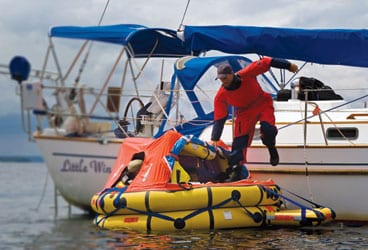
After a full day of climbing into, out of, over, and under a string of new life rafts, I couldn’t decide if it was my jump off the boat or the jump that followed mine that gave me the most pause for thought. The first came about as I stood amidships on Little Wing, the Passport 40 we’d borrowed for the day. It was August in Rhode Island, and I wore my foul-weather jacket and had a life jacket zipped tightly around me. Three feet below and a couple of feet from the deck, the gaping mouth of a Winslow ISO Global Star six-person life raft awaited me and my three colleagues lined up along the rail.
Streaming out behind us were seven more life rafts (a ninth was tested on another day), representative of the latest generation of safety equipment being built to standards now mandated by some offshore-racing and rally organizers. While we weren’t conducting a formal test, the CW editorial team had decided to review the features of each raft, spend some time using them, then pass along our findings to readers to help you consider the many options available.
No time being like the present, I stepped to the lifelines and made the leap. As I landed and slipped quickly to my knees, I felt cold water rush around my legs and up my coat as I scurried out of the entranceway. I’d always wondered how it would feel to abandon ship, and though this was but a drill, that first step from a solid deck to a watery, bouncy raft had been, well, different.
Then came the second jump. With a dull thud, heavy boat shoes hit the life raft’s floor. They came in fast and threatening. The floor pitched, and Doug Ritter, executive director of Equipped to Survive, tumbled into me as he slid out of the doorway and off to the side to make way for the others. Quickly, our consultant on this project, Steve Callahan, the author of Adrift, the chronicle of his 76 days in a raft crossing the Atlantic, and CW managing editor Elaine Lembo followed, with knees and elbows flying. And then there were four of us under the fabric canopy, sizing up the space and imagining what it would be like if we were really calling this home until rescuers arrived, what boarding might have been like if it were taking place at night and in heaving seas, and, most important, how easy, even in these controlled conditions, it would be for someone to be injured-when jumping or when being jumped upon-and for serious complications to quickly set in. Elaine, in fact, was about to get a too-real taste of trouble as we went through our planned assessment drill.
By day’s end, once we’d finished going through the inventory of safety equipment stored aboard each raft, Steve would conclude that, as with most things relating to boats, a lot of compromises had to be made on how each raft was designed, built, and equipped. As a group, we found notable variations in comfort, kit, and construction, but we also agreed that should we find ourselves on a sinking boat far from shore, we’d be pretty relieved to step aboard any of the rafts that we’d looked at.
First though, we had to put these puppies through their paces. As those aboard Little Wing let out our painter, we were pushed backward by the current that in a minute would make it hard for us to swim about in our foul-weather gear, life jackets, and other clothing. One by one we jumped into the water, then used the Winslow’s inflatable ramp and ladderlike webbing that runs across the raft’s interior to pull ourselves back aboard-a maneuver that took a surprising amount of upper-body strength and defied a graceful execution. Then we crowded to one side of the raft, used the strings hanging from the bottom to empty its ballast bags, and flipped it over, taking to the water again. We decided that Elaine, the smallest and lightest, would use the strap across the bottom of the raft to climb up its side and right it. It was hard work and took her a few tries, but soon the raft slowly rose and rolled back onto its bottom-landing on top of a disoriented Elaine. Though she was at the edge of the circular raft, her life jacket and wetsuit pushed her upward and into the floor. Quickly, Steve Callahan sized up the problem and pulled her, sputtering, free. Yes, these rafts are a serious business.
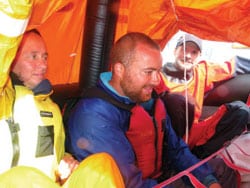
Gretchen Thor | | With 4 square feet per person, even a six-person raft is “cozy” when Sue Pillsbury (left), Mike Lovett, Steve Callahan, and a photographer are aboard. |
A Comparison of Features After consulting on the latest industry trends with Jim and Dan O’Connor, who run Life Raft & Survival Equipment, based in Portsmouth, Rhode Island, Cruising World editors decided to take a look at some of the new life rafts being built to standards drafted by the International Organization for Standardization and the International Sailing Federation, commonly referred to respectively as ISO and ISAF. (See “A Discussion of Life-Raft Standards,” page 64.) These rafts are required aboard sailboats participating in certain offshore-racing events, and often such requirements trickle down to cruiser-based rallies, such as the Atlantic Rally for Cruisers, which now mandates a life raft meeting International Convention for the Safety of Life at Sea (SOLAS), ISAF, or ISO 9650 guidelines. It’s likely, we felt, that this new generation of rafts could create a buzz at boat shows when customers inquire about new products.
The manufacturers that participated in our review included DSB, Revere Survival Products (the sole raft in our study that isn’t built to a particular set of standards but is intended for offshore work), Switlik Parachute Company, Viking Life-Saving Equipment, Winslow Life Raft Company, and Zodiac. In a separate session, we also took a look at a raft that Zodiac builds to specifications developed by West Marine.
Both manufacturers and safety experts on hand for our session were quick to point out that while there are valuable features in these standards-based rafts, there are some tradeoffs, too, primarily because these rafts tend to be heavier and more expensive. Unless one is planning to sail in an offshore race or rally, there may be no need to upgrade from your old raft or pay a premium for one of the models we looked at.
What was clear as the rafts were inflated, one after the other, is that there are a lot of variations to consider. Such factors as raft shape, tube construction, canopy height, floor insulation, door size, and ventilation can have a pronounced effect on comfort and performance offshore. Round rafts are thought perhaps to be more stable, rectangular ones more comfortable for stretching out, and high canopies may make it easier for tall people to sit up for long periods. But stability also depends to a large degree on the form and function of the raft’s ballast bags, while a high canopy that allows for headroom will increase windage, meaning you may drift farther afield from where your EPIRB initially signaled. Of course, if the emergency signal stopped broadcasting, that increased windage might help you drift to shore faster, too.
On the Water To get a look at the rafts, we launched most from a dock, but we saved one packed in a valise and one in a canister to deploy from the deck of Little Wing. Our learning curve began as we carried each raft down the dock to be thrown off. Those packed in hard-shell canisters, which outweigh valises by about 10 pounds, were heavy, and almost all were hard to grip. On a pitching deck, it would be tough work for a shorthanded crew to move one of these about. That said, most canisters sit in a deck-mounted bracket and wouldn’t need to be moved far to reach the rail. Still, some straps or handholds are needed; one offered only a fingertip grip where the two halves of the canister came together. The valises, with their hand straps, were much easier to handle, thought it was tough to imagine lugging one up from below in less than 15 seconds, which is one of the safety criteria cited by U.S. Sailing.
Once each raft was launched, the painter was tugged to fire off the inflating mechanism. Because rafts may be deployed in a wide range of temperatures, there’s extra gas in the inflation canister. We soon got used to the loud hiss of excess gas venting from the expansion valves. Callahan said that in the fury of an emergency, that hissing is often mistaken for a leak. But expansion valves are needed since pressure within the rafts’ tubes changes with temperature and must be allowed to vent.
With the launch of each raft, we witnessed many variations in features: inflatable boarding ramps, ladders made from webbing, fold-down fabric ramps, small doors, large doors, windows, observation hoods, and several different locations where painters might be attached. In the drills that would follow, we’d find that each variation had its pros and cons. Small doors make for good protection from the elements, but landing in such a hole when jumping aboard is harder. Webbing rungs designed for easy boarding can tangle legs. And a painter that keeps the door of the raft facing the opening in the lifelines can make boarding from the water all the more difficult. To me, the biggest takeaway from this preliminary assessment was this: Whatever raft you buy, you’ll be well served to find an opportunity to become familiar with it before you need to use it on some dark night. Dealers and manufacturers either run training sessions or can point you to a third party so you can at least experiment with a similar model. Or better yet, when your raft is due for servicing, your repack station can open it with you in a controlled manner that won’t add wear and tear to the raft.
A Look at the Rafts
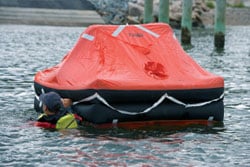
Gretchen Thor | | DSB ISAF Standard |
DSB ISAF Standard: DSB provided a pair of four-person rafts built to ISAF requirements, its ISAF Standard and its ISAF Ocean XR Self-Righting. The Standard, roughly rectangular in shape, comes packed in a valise. At 55 pounds, it’s the lightest we looked at. Inflated, the canopy has a generously sized opening on one side that uses a zipper and hook-and-loop fasteners to seal out the elements; there’s an observation hood, or inspection port, across from it. Outside the entrance, a fabric ramp folds down on webbing, with a web ladder underneath it so you can get a knee up when climbing in from the water. In general, we found it more difficult to climb aboard rafts with fabric rather than inflatable ramps.
The inner floors of both DSB rafts are made from insulated material (think cellular foam) with a surface that reflects heat back into the raft. On these rafts, the floors were attached to buttons in the corners, and both liners came loose as we moved about. We also found that the emergency equipment wasn’t adequately secured and tended to clutter the entranceway as we climbed aboard. Both rafts had conical sea drogues, some of the better we saw, made from a mesh material that would let water pass through.
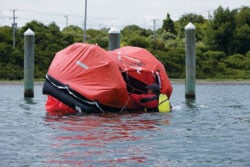
Gretchen Thor | | DSB ISAF Ocean XR Self-Righting |
DSB ISAF Ocean XR Self-Righting: Similar in shape to the Standard but with double arches, the self-righting ISAF Life Raft has an entrance on its longer side, which can be closed with a zipper and hook-and-loop fasteners, and a fold-down fabric entry ramp with webbing below. As in the Standard, there was a good ladderlike mesh of handholds running across the interior of the raft from the entryway, but unlike some rafts, this couldn’t be disconnected when everyone was aboard to get it out of the way. Once capsized, the raft needed only a little push to self-right; in waves it probably wouldn’t have needed help. While four could easily fit in either of the DSB rafts, quarters were tight, and all aboard concluded that if planning for a crew of four, a six-person raft would be worth the added expense. (DSB also manufactures 6-person rafts.) The extra space would also allow each crew to carry his or her own ditch bag, a practice recommended by safety experts. (Go to www.cruisingworld.com/1108ditch for more on ditch bags.)
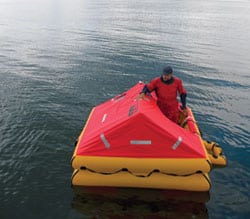
Gretchen Thor | | Revere Offshore Elite |
Revere Offshore Elite: The six-person raft from Revere is built for offshore sailing but not to ISO or ISAF standards. Packed in a valise, it weighs just 63 pounds, making it relatively easy to lift. Inflated, the raft is square, with an ample doorway and a large entrance ramp that inflates with the raft. The raft’s canopy is relatively low and brightly colored for visibility. There’s a quilted inner floor that can be inflated to aid in the prevention of hypothermia in colder water, and a zippered window across from the opening serves as an observation window and provides cross ventilation. The exterior of the raft is well marked with reflective tape, but we found that when launching the raft, it was difficult to find on the valise the black patch secured by hook-and-loop fasteners that peeled off to expose the painter. We also found that the features of the raft itself weren’t as well marked as on some of the other models. Although the raft comes with an older, parachute-style sea anchor, a bonus feature is that it automatically deploys when the raft inflates. On the raft we looked at, safety gear wasn’t tied down well and, as on several of the rafts we capsized, tended to get strewn about.
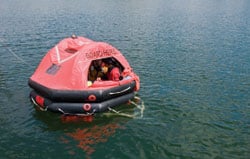
Gretchen Thor | | Switlik MD-3 International Offshore |
Switlik MD-3 International Offshore: The Switlik six-person raft is built to both ISO and ISAF standards and came packed in a valise with lots of handholds that made moving the 97-pound package more manageable. When inflated, the octagonal-shaped Switlik has ample entrances on two sides and clear observation windows on two other sides. There’s a fold-down fabric ramp, with web steps below, in front of one entrance and a web ladder at the other entrance. When boarding from the boat, the Switlik’s main opening can be easily held in front of the lifeline gate because the painter attaches to a triangular bridle anchored to either side of the boarding ramp. However, when a swimmer enters the raft from the water while the raft is still tethered to the boat, this bridle gets in the way and makes it difficult for the person in the water to get a knee in place on the ramp. We found that good handholds made the second entrance an effective alternative for a swimmer. Inside, we found the canopy was well supported and had good headroom, and both entrances featured zippers to seal out the elements.
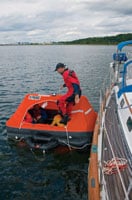
Gretchen Thor | | Viking RescYou |
Viking RescYou: Viking supplied two six-person rafts for our comparison, a standard model and a self-righting model; both are built to ISO and ISAF standards. The square-shaped RescYou standard raft was packed in a valise and weighs 77 pounds. Inflated, the tent-shaped canopy has one large opening whose flap can be sealed with a heavy-duty zipper; there’s an observation port/hood opposite for watchkeeping. At the entrance, there’s a rubber inflatable step with a webbing step that hangs beneath it. We found that this arrangement worked well when boarding from the water. The painter attaches to one corner of the raft, however, so we couldn’t hold the entrance square-on to the opening in the lifelines. The buoyancy tubes on both Vikings are made of two layers of natural rubber with a nylon core, which produces a tough, abrasion-resistant material. Inside both the rafts, the ladderlike handholds, made of webbing, can be untied and moved out of the way. We found well-secured gear bags in these rafts, with sea anchors lashed to them so the drogues could be found and deployed quickly after boarding, if needed. Moreover, Viking uses improved Icelandic-style drogues that have lines on their bridles so they can’t become tangled if they spin in the waves.
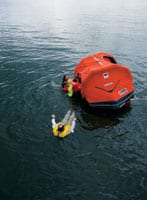
Gretchen Thor | | Viking RescYou Pro |
Viking RescYou Pro: The six-person self-righting raft we inflated came packed in a canister, which helped to make it one of the heavier we launched. The self-righting Pro model, rectangular in shape, has pointed ends that help increase buoyancy, and a well-supported arched canopy. Inflated, it has two large openings that can be sealed tight by flaps with heavy zippers. Like the standard RescYou, the Pro has an inflatable inner floor. All of the rafts we looked at rely on ballast bags that hang below the raft for stability. On several of them, it took two or three people leaning on one side to tip them over, but neither Viking could be tipped without a swimmer in the water to manually empty the ballast bags. Once up-ended, the Pro righted itself unassisted immediately, thanks to the large tubes that support the canopy.
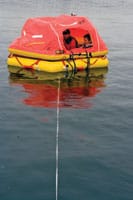
Gretchen Thor | | West Marine ISAF Bluewater |
West Marine ISAF Bluewater: The six-person Bluewater raft is built by Zodiac to West Marine’s specifications with a nylon and butyl rubber sandwich. The raft is hexagonal in shape, which combines with double arches to provide better headroom. The arched, bright-orange canopy has two openings, one with a large self-inflating boarding ramp, the other with a web ladder that extends well below the surface. Both worked well when boarding from the water. A valve in one of the canopy arches on the raft we tested was apparently not seated properly and leaked as we boarded the raft. Our attempt to reinflate the tube was at first successful, but subsequently the hose on the emergency pump broke, a good reminder of Callahan’s advice always to carry a spare pump in your personal ditch bag. Callahan also noted as a plus that the valve used also allows one to reinflate the tube by mouth, if need be. Safety equipment was well secured in the raft, and the gear bag contained a good array of items, including clamps of several sizes to repair the raft in an emergency. The raft has a black inflatable floor that can be pumped up to provide insulation in cold water.
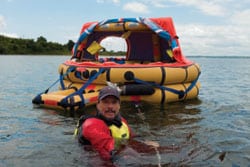
Gretchen Thor | | Winslow ISO Global Star |
Winslow ISO Global Star: The six-person Winslow raft, built to ISO standards, comes packed in a valise and weighs 99 pounds. Of all the rafts, this was the easiest to get into from the boat. Round in shape, it inflates with half of its canopy folded back, creating a large target to jump toward. The canopy can be fully removed for the tropics or zippered front and back to seal out the elements. Zippered windows can be opened for ventilation and for keeping a lookout. An inflatable ramp is found on one side of the raft and a web ladder on the other. We found that features and equipment are well marked; there’s no confusion about where to board, where to grip to right the raft, or what the function of a particular valve is. While the buoyancy bags on some of the rafts took some time to fill, Winslow has come up with a spring system that forces the bags to open and draw in water, so stability is quickly achieved after launching. The idea of internal ladderlike handholds made of webbing, which we saw in several of the rafts, was pioneered by Winslow, and in this raft, the ladder was easily removed with a clip. The Global Star comes packed with well-secured safety equipment, including a spare sea anchor. The primary sea anchor is self-deployed during inflation.
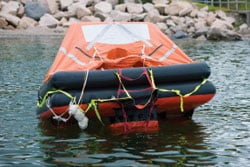
Gretchen Thor | | Zodiac Offshore ISAF |
Zodiac Offshore ISAF: At 95 pounds and packed in a canister, the Zodiac was one of the heavier rafts we launched, though moving it about was made somewhat easier thanks to carrying straps. We did find, though, that the canister, when lying flat and lifted, tended to quickly tip on its side. Inflated, the raft has a tent-shaped canopy and a fold-down fabric boarding ramp and good-sized entrances facing each other across the square-shaped craft. Inside, an aluminum-lined composite cellular foam floor acts as in insulator and reflects body heat back into the raft. The raft we looked at is used by Life Raft & Survival Equipment as a demonstrator and had seen multiple inflations, so we didn’t get a chance to inspect the ditch gear as supplied by the manufacturer. Company literature, however, indicates that it meets offshore ISAF requirements and is secured in a bag.
Mark Pillsbury is CW’s senior editor.
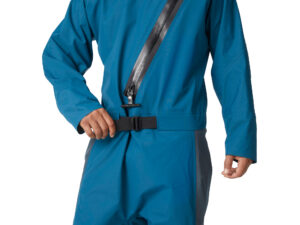
Mustang Survival’s Quadra Dry Suit
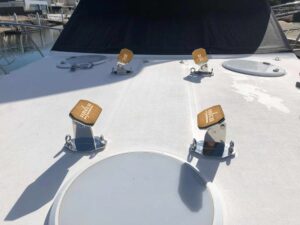
AquaChocks: Secure Tender Storage, Simplified
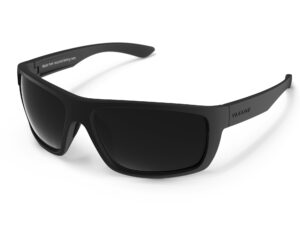
Pro-Grade Sailing Eyewear
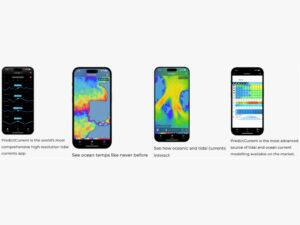
PredictWind Introduces PredictCurrent App
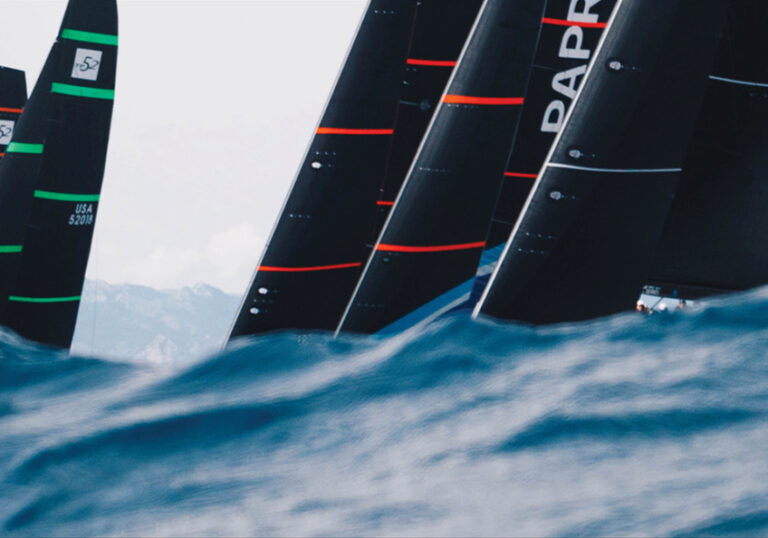
North Sails Parent Company Buys Doyle, Quantum
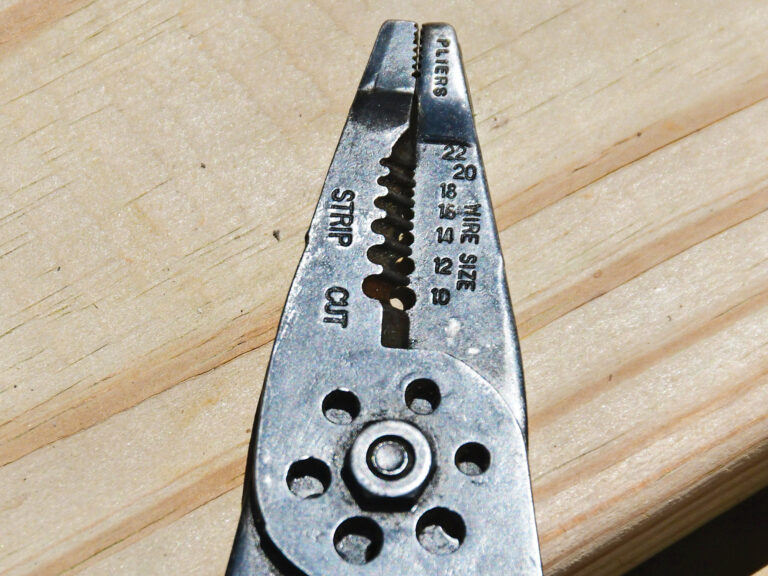
Top Tools for Sailboat Cruising: Must-Have Gear for 2024
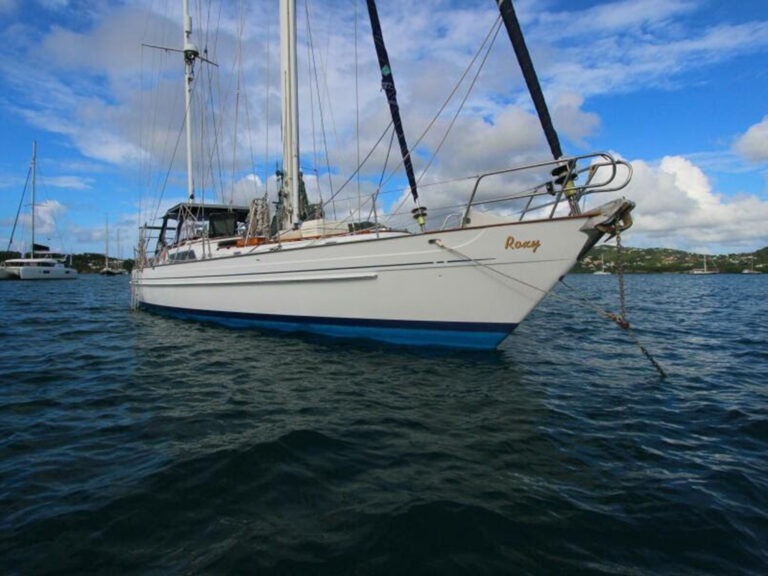
For Sale: 1984 Camper & Nicholsons 58
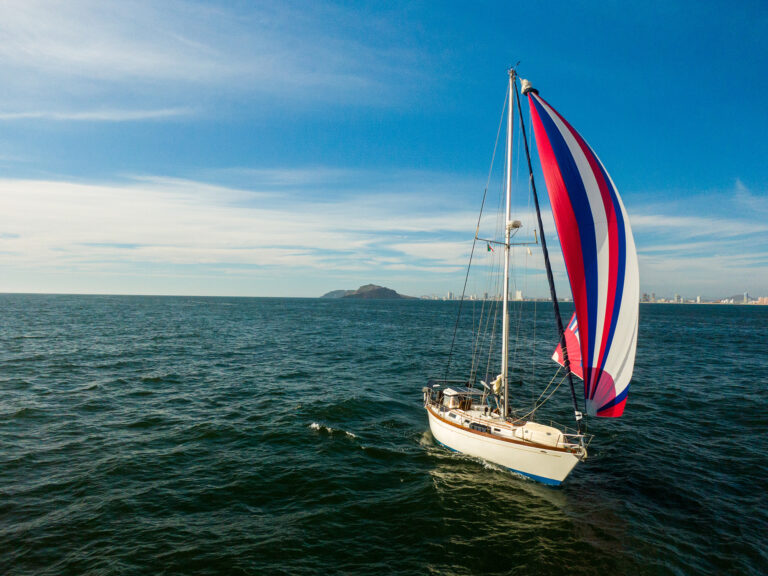
Sailing Avocet : A New Adventure Begins
- Digital Edition
- Customer Service
- Privacy Policy
- Terms of Use
- Email Newsletters
- Cruising World
- Sailing World
- Salt Water Sportsman
- Sport Fishing
- Wakeboarding
- Throw overboard
- Throw overboard, self-righting
- Davit-launchable
- Davit-launchable, self-righting
- Open reversible
- Sliding racks
- Column racks
- Additionals
- Launching instructions
Renowned for their unmatched dependability and robustness, our throw-overboard and davit launchable liferafts come in both standard and automated self-righting versions. VIKING liferafts undergo rigorous trials in challenging sea conditions and can be deployed in extremely high wind speeds and frigid temperatures. To meet the demands of polar climates, VIKING offers a dedicated liferaft solution in a uniquely heated container.
88 products
Liferaft - VIKING, 4DK+, throw overboard (4 pers.)
Multiple options
Liferaft - VIKING, 6DK+, throw overboard (6 pers.)
Liferaft - viking, 8dk+, throw overboard (8 pers.), liferaft - viking, 10dk+, throw overboard (10 pers.), liferaft - viking, 12dk+, throw overboard (12 pers.), liferaft - viking, 16dk+, throw overboard (16 pers.), liferaft - viking, 20dk+, throw overboard (20 pers.), liferaft - viking, 25dk+, throw overboard (25 pers.), liferaft - viking, 35dk+, throw overboard (35 pers.), liferaft - viking, 6dk+, throw overboard (6 pers.), extended service interval.
L006D027200NCA
Liferaft - VIKING, 8DK+, throw overboard (8 pers.), extended service interval
L008D027200NCA
Liferaft - VIKING, 25DKS, throw overboard, self-righting, (25 pers.)
Liferaft - viking, 10dk+, throw overboard (10 pers.), extended service interval.
L010D027200NCA
Liferaft - VIKING, 12DK+, throw overboard (12 pers.), extended service interval
L012D027200NCA
Liferaft - VIKING, 16DK+, throw overboard (16 pers.), extended service interval
L016D027200NCA
Liferaft - VIKING, 20DK+, throw overboard (20 pers.), extended service interval
L020D027200NCA
Liferaft - VIKING, 25DK+, throw overboard (25 pers.), extended service interval
L025D027200NCA
Liferaft - VIKING, 39DKS, throw overboard, self-righting, (39 pers.)
Liferaft - viking, 150dks, throw overboard, self-righting, (153 pers.), liferaft - viking, 35dk+, throw overboard (35 pers.), extended service interval.
L035D027200NCA

Please verify you are a human
Access to this page has been denied because we believe you are using automation tools to browse the website.
This may happen as a result of the following:
- Javascript is disabled or blocked by an extension (ad blockers for example)
- Your browser does not support cookies
Please make sure that Javascript and cookies are enabled on your browser and that you are not blocking them from loading.
Reference ID: 46a6d91d-6310-11ef-86f2-b57306eaad78
Powered by PerimeterX , Inc.
Life Raft Rentals
Depending on the type of boating you do, you may want to consider a life raft as additional peace-of-mind. some offshore fishing tournaments and sailing regattas require it. a life raft serves as a floating platform to keep you protected from the elements such as freezing cold water or scorching hot sun in the rare but serious event that you need to abandon your boat..
Exposure in open water is a dangerous thing. Most life rafts have a canopy. This provides minimal protection from exposure and can even collect and channel rain water for drinking. A life raft also serves as a larger visual target for rescuers to see, especially from the air.
Life rafts are carefully packed in a hard case (called a canister) or a soft case (called a valise) and are inflated by compressed gas, usually nitrogen and CO2 stored in a high pressure cylinder. Rafts come in several sizes, typically 4, 6 or 8 man capacity and range in price from around $2,000 to more than $10,000. They weigh anywhere from 20 lbs to 100 pounds.
For more on selecting a life raft, check out the West Advisor section on life rafts . Or, you may try one of the following places that rent them where you will likely have to pick one up. Due to the bulk of these units and the gas cylinders, you’re not likely to find affordable options to have one shipped to your location:
Related Topics:
- About Flares and Distress Signals
- How EPIRBs Work
- Satellite Phone Rental Companies
- Federal Requirements for Recreational Boats
Life Raft Companies
Search for a Life Raft Company in your area by visiting: United States Marine Safety Association — www.usmsa.org
California: Avalon Rafts — Wilmington 310-549-9665 Coast Marine — San Francisco 415-673-1923 Sal's Inflatable Services — Alameda 510-522-1824
Florida: Viking Life Saving Equipment — Miami 305-614-5800 Sun Coast Inflatables — Tampa 888-572-4317 (or) 727-572-4317 Lifeline Inflatable Services — North Miami 305-621-1500
Maryland: Vane Brothers — 800-440-8263
New Jersey: Sea Safety International — Secaucus 201-963-8493
Rhode Island: Life Raft & Survival Equipment, Inc – Tiverton 401-816-5400
Texas: C&M Marine Aviation Services Inc. — Dallas 877-878-4835
Washington: Puget Sound Inflatables, Inc. — Seattle 800-743-7238 (or) 206-762-3877 Westpac Marine Services, Inc. — Tacoma 800-343-5826
Virginia: Vane Brothers — 800-440-8263
Choosing the right life raft for your boat
Ensure the safety of your family and crew while sailing by choosing the right life raft for your boat - read our comprehensive guide to learn about the factors to consider and make an informed decision.
Choosing the Right Life Raft for Your Boat
As you embark on your sailing adventure, leaving the rat race behind and embracing the open sea, the safety of your family and crew should be your top priority. One of the most critical pieces of safety equipment on any boat is the life raft. In this comprehensive guide, we will explore the various factors to consider when choosing the right life raft for your boat, ensuring that you are well-prepared for any emergency situation that may arise.
Table of Contents
Why you need a life raft, types of life rafts, capacity and size, life raft features, storage and deployment, maintenance and inspection.
While we all hope to never find ourselves in a situation where we need to abandon ship, the reality is that accidents and emergencies can happen at any time. A life raft serves as your last line of defense in the event of a catastrophic event, such as a fire, collision, or sinking. It provides a temporary shelter and survival platform for you and your crew, increasing your chances of being rescued.
In addition to being a crucial safety measure, having a life raft on board may also be a legal requirement, depending on the size of your boat and the waters you plan to sail in. Many countries and sailing organizations have specific regulations regarding life rafts, so it’s essential to familiarize yourself with these requirements before setting sail.
There are several types of life rafts available on the market, each designed for different types of vessels and sailing conditions. The main categories of life rafts include:
Coastal Life Rafts
Coastal life rafts are designed for use in relatively sheltered waters, close to shore. They are typically lighter and more compact than offshore life rafts, making them suitable for smaller boats with limited storage space. However, they may not be as durable or well-equipped as their offshore counterparts, and they may not meet the requirements for boats sailing in more challenging conditions.
Offshore Life Rafts
Offshore life rafts are built to withstand the harsh conditions of open ocean sailing. They are generally more robust and better equipped than coastal life rafts, with features such as insulated floors, heavy-duty canopies, and more extensive survival equipment. These life rafts are suitable for boats that venture far from shore and may be required for boats participating in offshore races or cruising in remote areas.
ISO 9650 Life Rafts
The International Organization for Standardization (ISO) has developed a set of standards for life rafts, known as ISO 9650. These life rafts are designed to meet specific performance criteria and are subject to rigorous testing and certification. ISO 9650 life rafts are available in two types: Type 1 for ocean use and Type 2 for coastal use. Choosing an ISO 9650 life raft ensures that you are getting a high-quality, reliable product that meets international safety standards.
When selecting a life raft, it’s essential to consider the number of people it needs to accommodate. Life rafts are available in various capacities, typically ranging from 4 to 12 persons. It’s crucial to choose a life raft with a capacity that matches or exceeds the number of people on board your boat.
Keep in mind that the stated capacity of a life raft refers to the number of people it can accommodate in an emergency situation, not necessarily in comfort. In a real-life scenario, you may need to accommodate injured crew members or additional supplies, so it’s a good idea to choose a life raft with a slightly higher capacity than the number of people on board.
In addition to capacity, consider the size and weight of the life raft. Smaller boats may have limited storage space, so it’s essential to choose a life raft that can be easily stowed and deployed. Some life rafts are available in compact, lightweight models designed specifically for smaller vessels.
Life rafts come with various features designed to enhance their performance and survivability in emergency situations. Some key features to look for when choosing a life raft include:
Canopy: A canopy provides protection from the elements and helps to maintain body heat. Look for a life raft with a high-visibility canopy that is easy to erect and has adequate ventilation.
Insulated Floor: An insulated floor helps to protect occupants from cold water and provides additional buoyancy. This feature is particularly important for life rafts intended for use in cold water environments.
Ballast Bags: Ballast bags are weighted compartments that fill with water, helping to stabilize the life raft and prevent it from capsizing in rough seas. The more ballast bags a life raft has, the more stable it will be.
Boarding Ladder: A boarding ladder or ramp makes it easier for occupants to enter the life raft from the water, particularly in rough conditions or when wearing bulky survival gear.
Survival Equipment: Life rafts should come equipped with essential survival equipment, such as flares, signaling devices, a first aid kit, and water and food rations. Some life rafts also include additional items like a sea anchor, fishing kit, or repair kit.
Proper storage and deployment of your life raft are critical to its effectiveness in an emergency. Life rafts are typically stored in either a hard container or a soft valise. Hard containers are more durable and provide better protection for the life raft, but they can be bulky and heavy. Soft valises are lighter and more compact, but they may not offer the same level of protection.
When choosing a storage location for your life raft, consider the following factors:
Accessibility: The life raft should be easily accessible from the deck and cockpit, even in rough conditions or when the boat is heeled over.
Protection: The life raft should be protected from damage caused by UV exposure, chafing, or impact.
Deployment: The life raft should be stored in a location that allows for quick and easy deployment in an emergency. Some life rafts are designed to be mounted on deck or in a dedicated storage locker, while others can be stored in a cockpit locker or below deck.
Regular maintenance and inspection are essential to ensure that your life raft remains in good working order. Most life raft manufacturers recommend that their products be serviced and inspected every three to five years, depending on the model and usage. This service typically includes a thorough inspection of the life raft’s fabric, seams, inflation system, and survival equipment, as well as any necessary repairs or replacements.
It’s also a good idea to familiarize yourself with your life raft’s operation and practice deploying it in a controlled environment. This will help to ensure that you are prepared to use the life raft effectively in an emergency situation.
Choosing the right life raft for your boat is a critical decision that can have a significant impact on the safety and well-being of your family and crew. By considering factors such as the type of life raft, capacity, features, storage, and maintenance, you can select a life raft that meets your specific needs and provides the best possible protection in an emergency situation. Remember, a life raft is an investment in your safety and peace of mind as you embark on your sailing adventure, so choose wisely and sail with confidence.
Raytheon Technologies Businesses
- Collins Aerospace
- Pratt & Whitney

Marine Liferafts
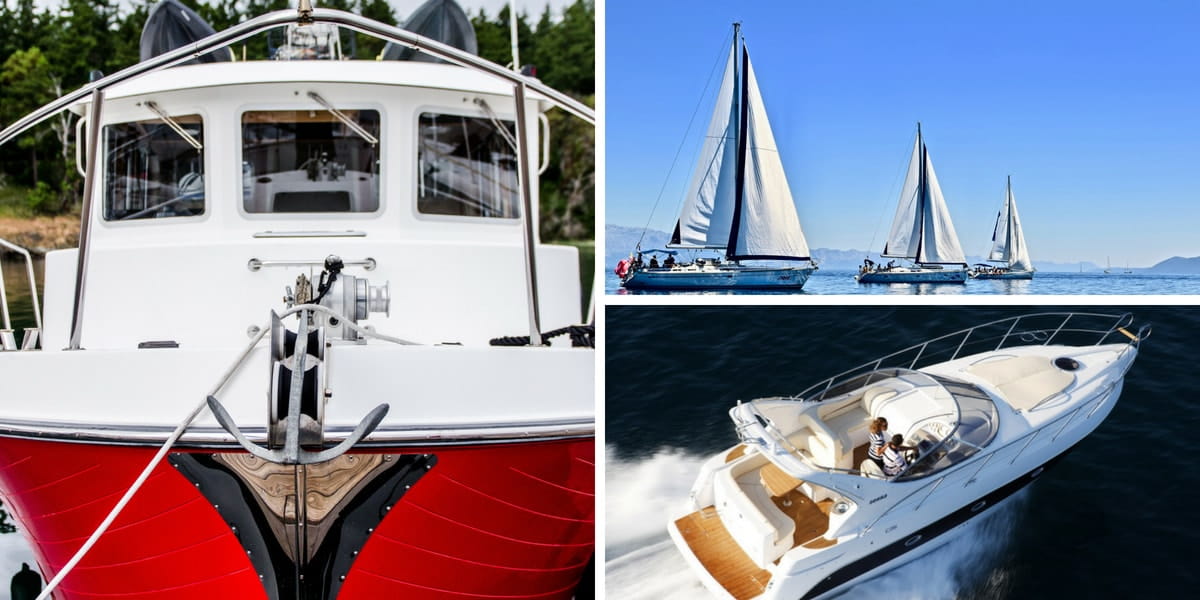
Winslow LifeRaft Company is the world’s leader for marine liferafts for the recreational boater and sailboat racer, built with only one thing in mind and that is to save your life. You operate the best equipment, and spare no maintenance, because safety is your number one priority. When nothing less than the highest level of safety is acceptable, Winslow delivers with minimum weight and maximum protection! Each liferaft is meticulously handcrafted and individually tested to compliment the exceptional safety and performance.
All Winslow marine liferafts are vacuum packed in Winslow’s UltimaWrap which provides a barrier to moisture and atmospheric contamination and extends the liferaft service to a full 3 years between scheduled maintenance.
Winslow offers many packaging options including hard packs, valise packs, and canisters for deck mounting. Winslow is also the industry leader in custom liferaft pack design. This custom pack feature, combined with the minimum weight, allows for more stowage options in or around the cockpit/helm area. Contact us for details regarding custom designed packs for specific boats.
With two different marine liferaft models, offshore and coastal, Winslow makes a marine liferaft to meet most any requirement that you may have.
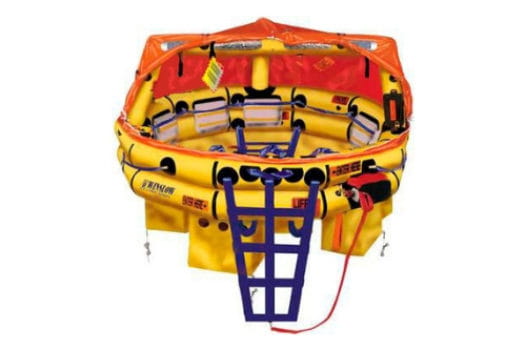
Ultra Light Offshore
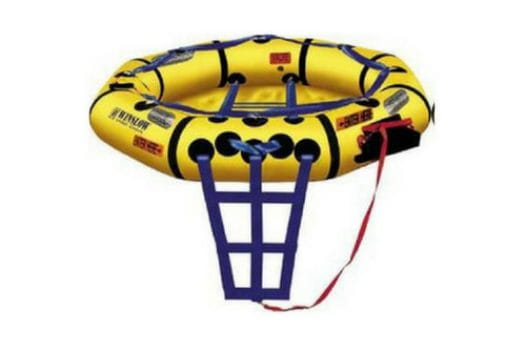
Super Light Rescue Raft
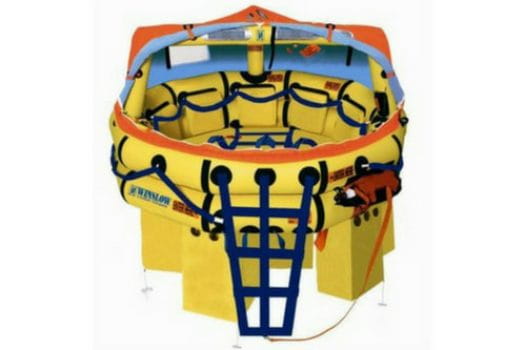
Super Light Offshore Plus
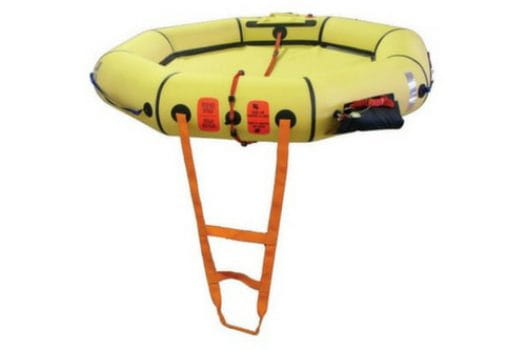
Law Enforcement Emergency Pac
Deploying a life raft.
Have a question?
Call 1-800-838-3012 or visit Contact Us for other ways to connect.
- Online Store
- RIBs & Outboards
- Testimonials

No products in the cart.
Fast Shipping
Secure Payment
Service Oriented
- Roll Up Boats
- Fiberglass Floor Boats
- Aluminum Hull Boats
- Professional & Rescue Boats
- Cadet Roll Up
- Cadet Fiberglass
- Cadet Aluminum
- Military Professional Inflatables
- Mini Inflatable Boats
- Crewsaver Aviation Life Rafts
- Revere Aviation Life Rafts
- Switlik Aviation Life Rafts
- Life Raft Accessories Supplies
- Cradles for Life Rafts
- Battery Replacement Services
- Life Jackets & PFDs
- EPIRBs & PLBs
- Survival Suits
- Lights, Marine Safety, USCG SOLAS
- USCG/SOLAS Signal Flares and Smoke Signals
- Survival VHF Radios & Accessories
- Carburetor Kits
- Fuel Fittings Connectors
- Fuel Line Assemblies
- Fuel Shut Off Valves
- Filters, Oil, Fuel & Air
- Outboard Service Manuals
- Water Pump Kits
- Inflatable Boat Fuel Tanks
- Inflatable Boat Emergency Repair Kits
- Inflatable Boat Glue, Adhesives & Sealants
- Inflatable Material PVC & Hypalon (CSM)
- Mugs & Coolers
- Insect Repellents
- First Aid Kits
- 🏷️ Sale & Clearance
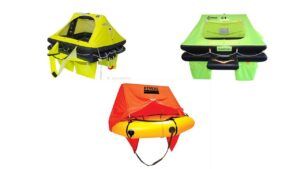
Yachting & Aviation Life Rafts (16)

Marine Life Rafts & Life Floats (17)
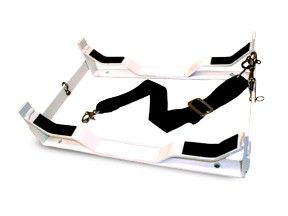
Life Raft Accessories Supplies (4)

Your privacy settings
Manage consent preferences, embedded videos, facebook advanced matching, facebook capi.
The 5 tragic minutes that sank a superyacht
PORTICELLO, Italy — Survivors of a storm that sank a superyacht off Sicily recounted their ordeal to one of the doctors who rushed to their aid, with some saying it took mere minutes for the 180-foot ship to go down.
Dr. Fabio Genco, head of the Palermo Emergency Medical Services, told NBC News on the phone Thursday that he arrived in the seaside village of Porticello before dawn Monday, about an hour after the $40 million Bayesian sank in the violent and sudden storm.
Of the 22 people onboard, 15 survived despite storm conditions and darkness, climbing onto a lifeboat before being rescued by a nearby sailboat. The crew members have made no public statements so far, though some have been interviewed by investigators.
“They told me that it was all dark, that the yacht hoisted itself up and then went down,” Genco said, recounting what the survivors told him. “All the objects were falling on them. That’s why I immediately made sure, by asking them questions, if they had any internal injuries,” he said.
It appears they had just minutes to abandon the sinking ship, Genco said.
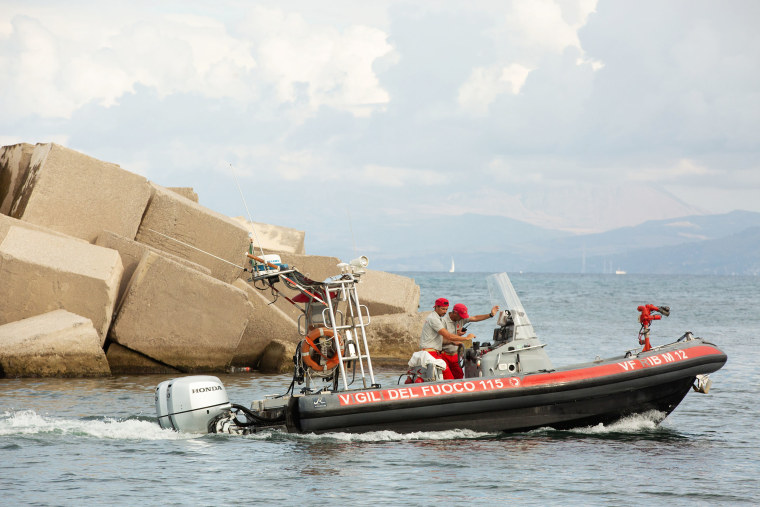
“They told me that suddenly they found themselves catapulted into the water without even understanding how they had got there,” he said, “And that the whole thing seems to have lasted from 3 to 5 minutes.”
Giovanni Costantino, CEO of The Italian Sea Group, which owns Perini Navi, the Bayesian's shipbuilder, told Sky News that there were no flaws with the design or construction of the yacht. He said their structure and keel made boats like that “unsinkable bodies.”
In an interview with the Italian newspaper Corriere della Sera, he disavowed responsibility, blaming instead the actions of the crew. “Mistakes were made,” he said.
Genco said one of his colleagues who arrived at the scene before him initially thought that only three people survived, but the coast guard reported there were other survivors and more emergency services were called in.
When Genco arrived, he found scenes of panic and despair.
“Unfortunately, we are used to such panic scenes because we are used to the shipwrecks that happen on Lampedusa ,” Genco said, referring to the island southwest of Sicily, where the wreckage of boats carrying migrants on the sea journey from North Africa to Italy are often found .
Six of the passengers were declared missing Monday, and by Thursday, the bodies of five had been recovered from the wreck , some 160 feet underwater.
Among those who survived is Angela Bacares, wife of the British tech mogul Mike Lynch , whose body was recovered Thursday.
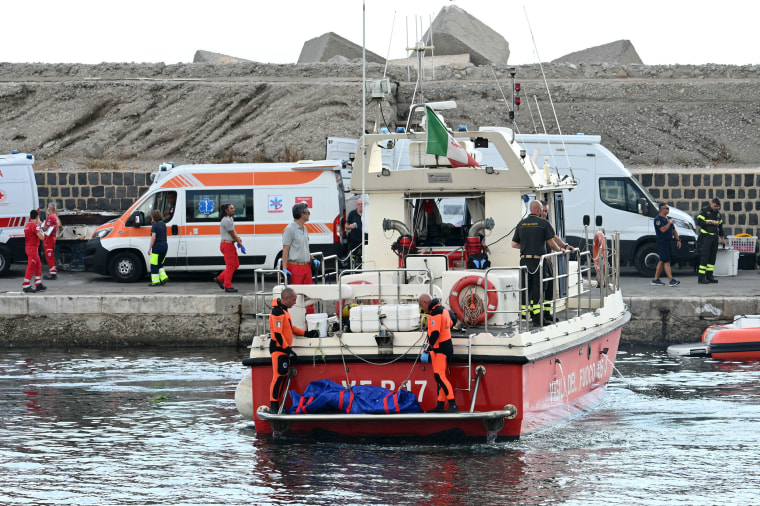
Another survivor has been identified as Charlotte Emsley, 35. She told the Italian news agency ANSA that she had momentarily lost hold of her year-old daughter, Sofia, in the water but managed to retrieve her and hold her over the waves until a lifeboat inflated and they were pulled into safety.
Dr. Domenico Cipolla at the Di Cristina Children’s Hospital in Palermo is also part of a team of medical professionals treating the shipwreck survivors. He told the BBC on Wednesday that Emsley and her daughter, as well as the father of the child, who Cipolla said also survived, are continuing to receive psychological help.
“Psychological support was constant and is constant even today, because basically it is the wounds of the soul that are the most in need of healing in these cases,” Cipolla said.
Genco also told NBC News that he was especially concerned about the child. “She did not understand anything. She was soaking wet and cold,” he said.
Karsten Borner, the Dutch captain of the Sir Robert Baden Powell, a yacht that was anchored near the Bayesian, said by phone Wednesday that he saw a thunderstorm come in at around 4 a.m. local time (10 p.m. ET) Monday, followed by what looked like a waterspout, a type of tornado that forms over water.
The International Centre for Waterspout Research noted on X that there was a “waterspout outbreak” off Italy on Monday, the day the Bayesian sank.
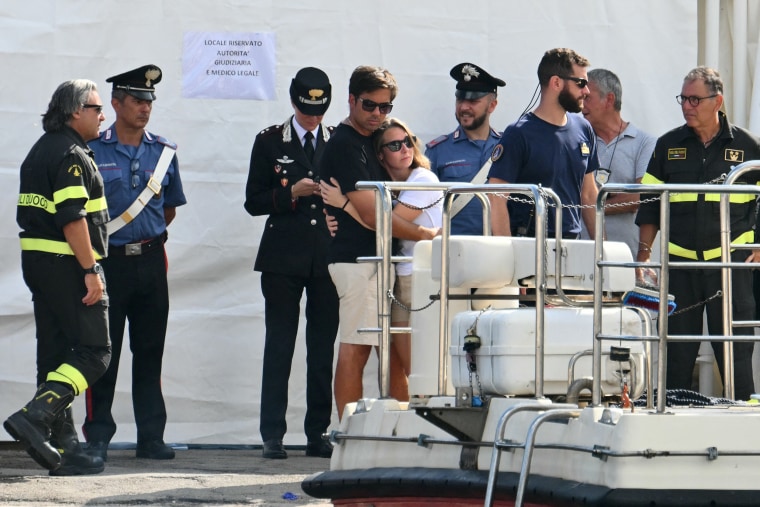
“I turned on the engine and made maneuvers so that we wouldn’t collide with the Bayesian, which was anchored about 100 meters from us,” Borner said. “Then all of a sudden it disappeared. Then the wind calmed down, we looked around and saw a red flare.”
Borner said he got into his boat’s tender and saw a life raft with 15 people on it. Members of the crew were administering first aid.
“I don’t know why it sank so quickly, but it may have something to do with the mast which was incredibly long,” he said. Questions have been raised about whether the mast was to blame for the accident as tall masts, even with the sails down, have more surface area exposed to the wind, which can contribute to tipping a vessel in a storm.
The CCTV footage that emerged Tuesday showed the yacht’s 250-foot mast, believed to be one of the tallest aluminum sailing masts in the world, lashed by the storm as it appears to tilt to one side before disappearing.
Claudia Rizzo is an Italy based journalist.
Claudio Lavanga is Rome-based foreign correspondent for NBC News.
Yuliya Talmazan is a reporter for NBC News Digital, based in London.
- TV & Film
- Say Maaate to a Mate
- First Impressions - The Game
- Daily Ladness
- Citizen Reef
To make sure you never miss out on your favourite NEW stories , we're happy to send you some reminders
Click ' OK ' then ' Allow ' to enable notifications
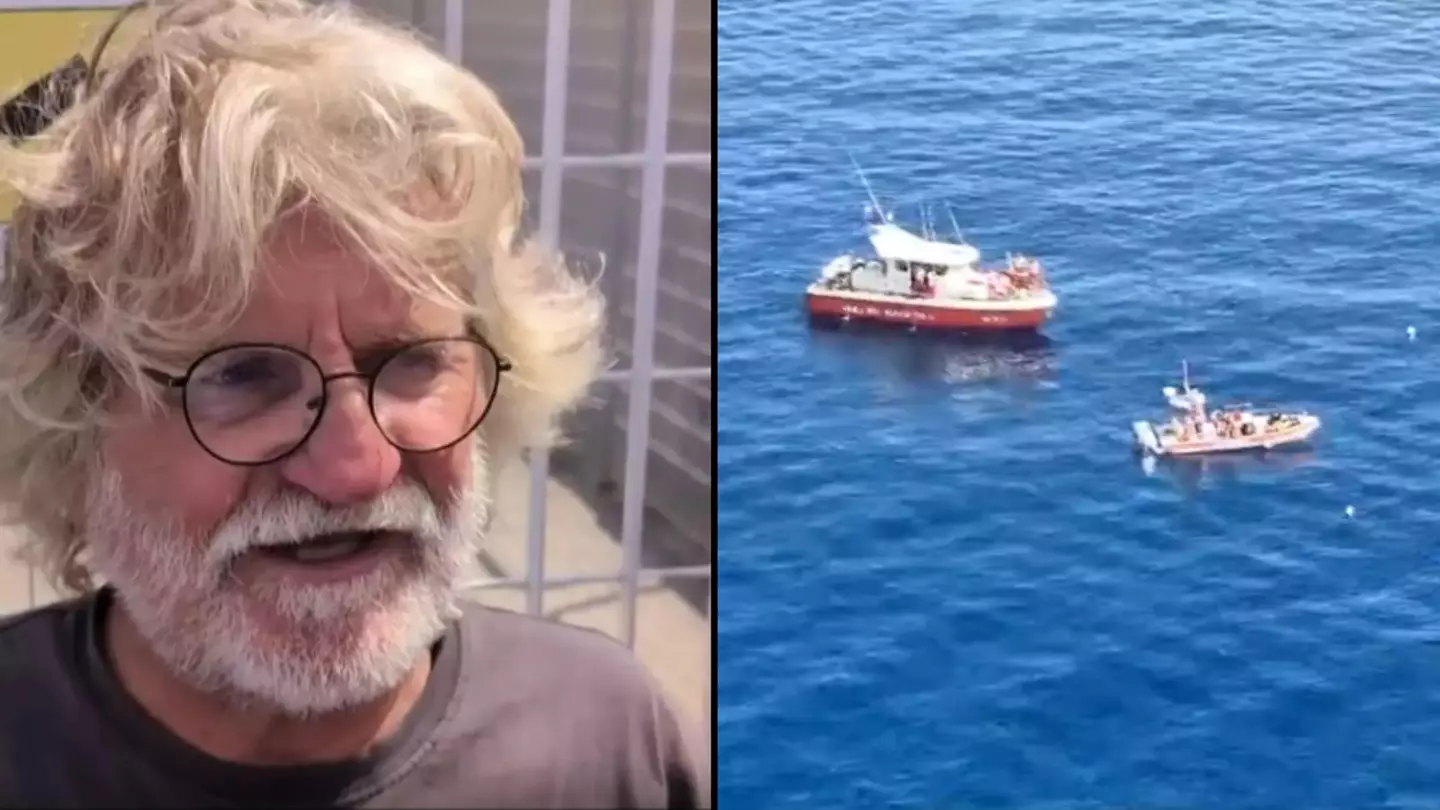
Captain of boat that helped rescue passengers on sunken £14m yacht speaks out on moment it went underwater
Karsten borner found the life raft with surviving passengers, revealing what him and his crew went through in the middle of the storm.
Joshua Nair
The valiant captain of a boat that helped to rescue 15 passengers and crew from the doomed Bayesian superyacht has described what he saw when he got to the sinking ship.
Karsten Borner spoke about his experience while manning his boat, which was close to colliding with the £14 million vessel in the midst of a tornado hitting the coast of Sicily Monday (19 August) morning.
The horrid weather capsized the 55-metre Bayesian superyacht, which was also carrying 22 passengers and crew at the time, with six still currently missing , as authorities continue their search.
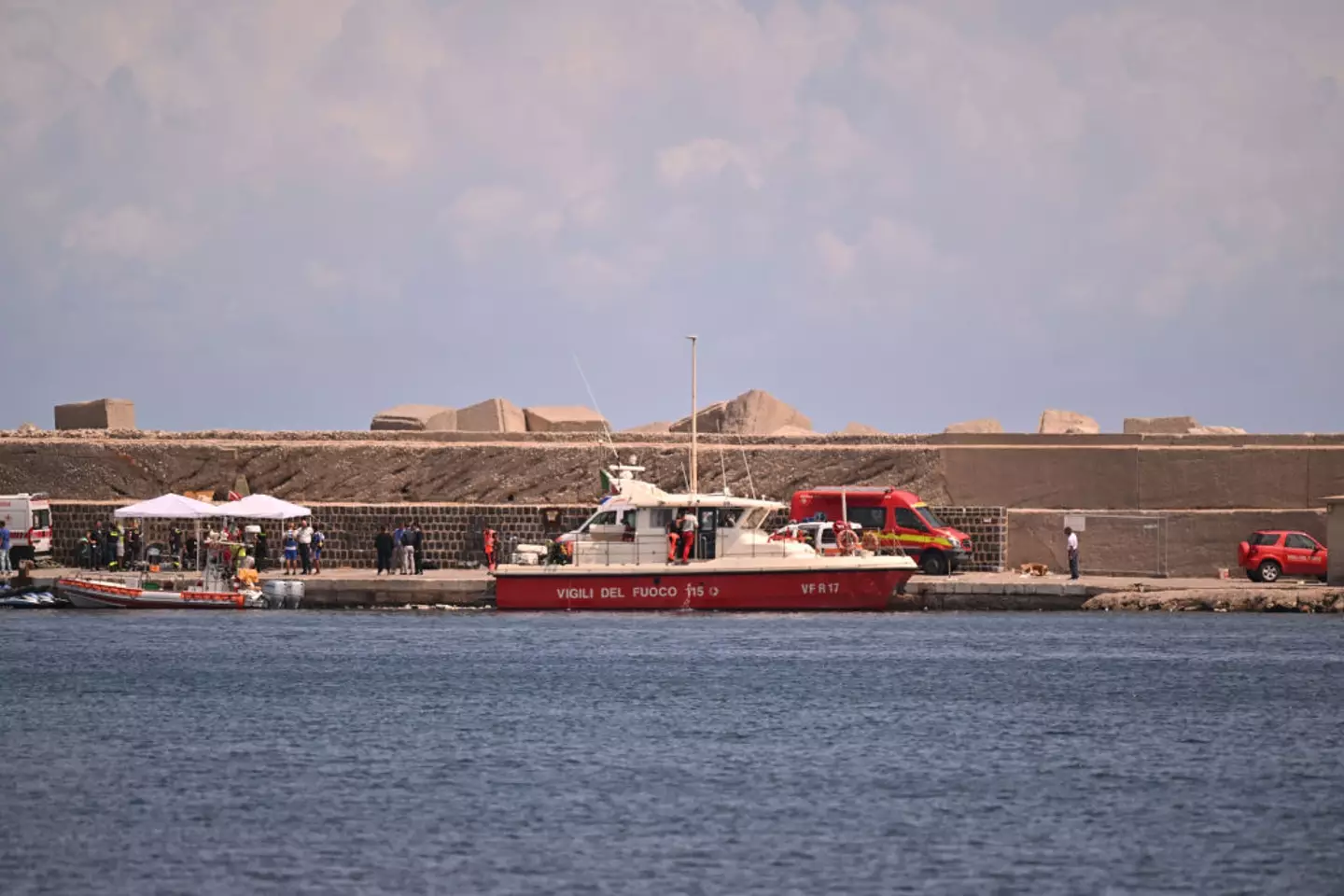
One of the missing people has been confirmed to be the owner of the vessel, UK tech tycoon Mike Lynch , known as the ' British Bill Gates', along with his 18-year-old daughter Hannah. His wife, Angela, made it out safely.
Most passengers were in their cabins when the tornado hit, though divers sent down to look for bodies claimed to have found 'corpses' in the vessel's portholes .
Very few people saw the state of the superyacht in the early morning yesterday, but Borner was very vivid in his recollection of the moment, as he explained to Global News: "We managed to keep the ship in position, and after the storm was over, we noticed that the ship behind us was gone."
Even though it was anchored up near the Porticello port in Palermo, the heavy rainfall caused the superyacht to start sinking as it filled with water, as he said that Lynch's yacht 'went flat on the water and then down'.
Borner was manning the Sir Robert BP as him and his crew were slapped with strong gusts of wind and torrential rainfall, meaning that they anchored up near the Porticello port as well.
Borner continued: "There was a light and we saw that the ship was aside and then we saw a triangle. So I think she went back down," before adding that he had noticed the superyacht vanish just before seeing a flare in the water with rising smoke.
There was a life raft out at sea with 15 people inside, including a one-year-old baby, as Borner thought quickly to inform the coastguard, who came out to guide the raft to safety.
Following the capsizing, Borner said that four people were injured, while three needed medical treatment .
The mum of the rescued one-year-old, Charlotte Golunski, says flooding in the yacht woke her up, with thunder and lightning leaving the yacht rocking according to her and her partner, James Emslie.
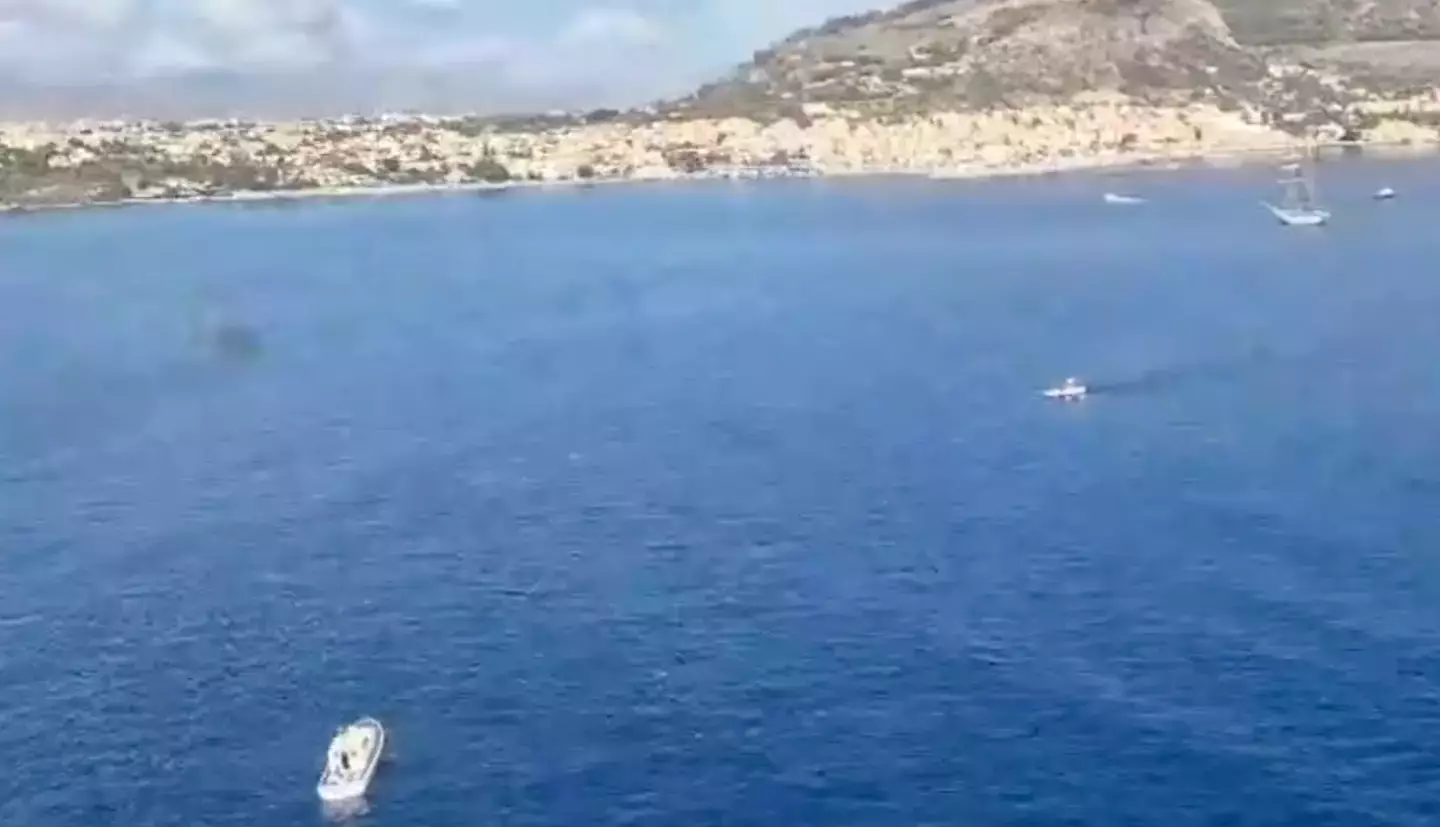
Young Sophia was clutched onto as Charlotte revealed her side of things to la Repubblica: “I held her afloat with all my strength, my arms stretched upwards to keep her from drowning.
“It was all dark. In the water I couldn’t keep my eyes open."
James wasn't able to find his family after initially being swept away at sea.
Seven tourists and crew didn't make it on the lifeboat, with one body, Chef Ricardo Thomas found among the wreckage.
Most of the missing people are passengers, as charterers said there were 12 guests and 10 crew sailing at the time.
Topics: Health , News , Travel , Weather , World News , Bayesian yacht
Joshua Nair is a journalist at LADbible. Born in Malaysia and raised in Dubai, he has always been interested in writing about a range of subjects, from sports to trending pop culture news. After graduating from Oxford Brookes University with a BA in Media, Journalism and Publishing, he got a job freelance writing for SPORTbible while working in marketing before landing a full-time role at LADbible. Unfortunately, he's unhealthily obsessed with Manchester United, which takes its toll on his mental and physical health. Daily.
@ joshnair10
Choose your content:

Update on 'Doomsday Glacier' that could have devastating effects as scientists disclose if it's likely to collapse
We're always keeping an eye on it to see what happens.

Brits complain of foul smell after Met Office issues statement on toxic sulphur dioxide cloud travelling through UK
A sulphur dioxide plume from the volcano eruption in iceland has been making it's way across the uk.

Astronaut waves and flips his camera to shut down flat Earth theory once and for all
Not like we need anymore proof that the earth is round.
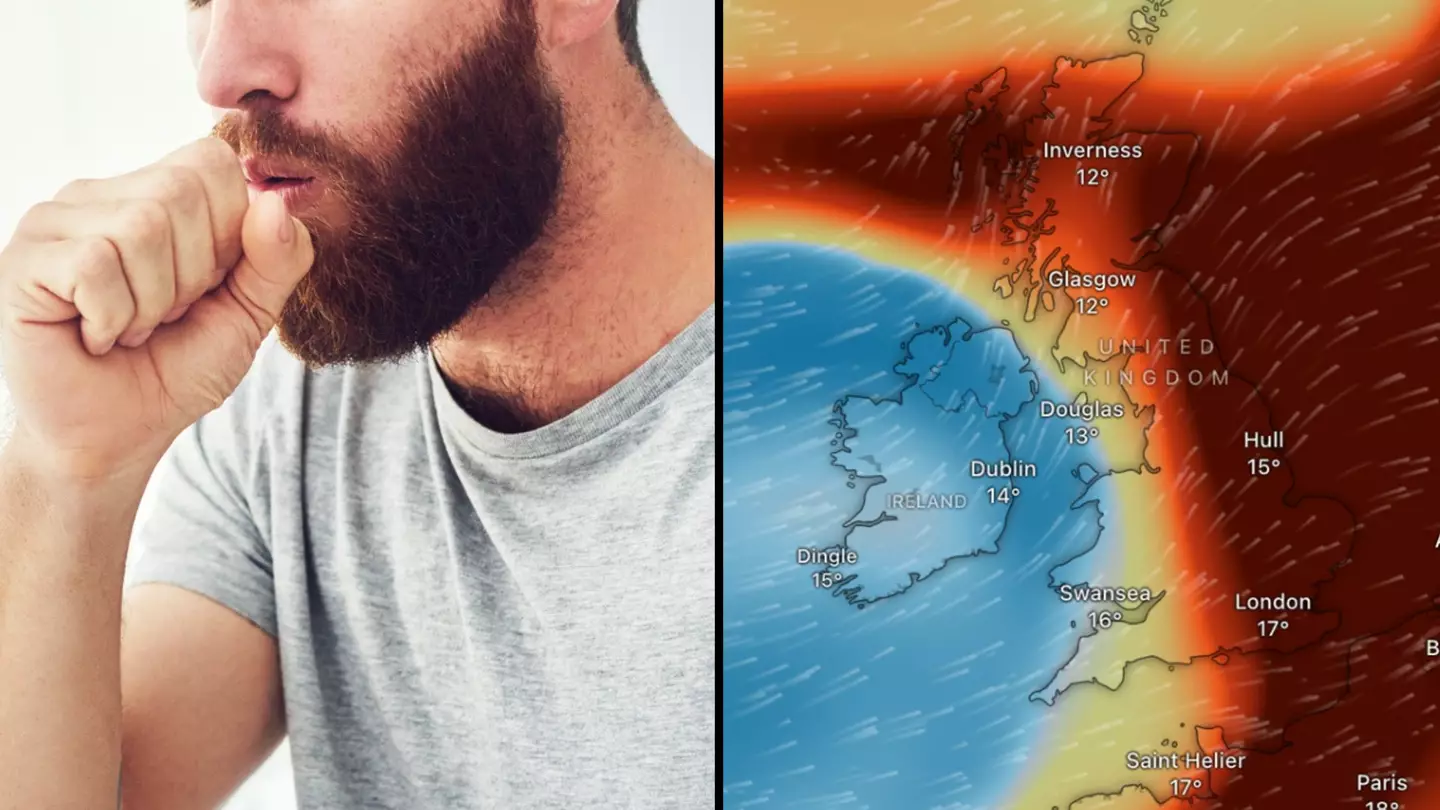
Brits warned about potential symptoms with toxic cloud dangerous to humans on way to UK
The met office has spoken out, and here's what you need to know.
- Brother of missing billionaire on yacht says missing people could still be alive due to 'air pockets'
- Inside the luxury £30m yacht that sank in Italy with billionaire Mike Lynch on board
- Pilot's last words revealed before tragic Brazil plane crash killed all 62 passengers on board
- Eerie dystopian footage shows Dubai underwater as two years' worth of rain hits holiday destination

2 Americans, U.K. tech mogul among 6 missing after yacht sinks off Sicily
Rome — Six people, including two U.S. nationals, a British technology entrepreneur and one of his daughters, were still missing Tuesday after a large luxury sailing yacht sank off the coast of the southern Italian island of Sicily during a violent storm. The 184-foot Bayesian had been anchored about half a mile off the port of Porticello, near Palermo, with 22 people on board — 10 crew members and 12 passengers.
The vessel sank at about 5 a.m. local time (11 p.m. Eastern, Sunday) after being hit by a possible waterspout spawned by the storm. Italian media said the winds snapped the boat's single mast, unbalancing the vessel and causing it to capsize.
Fifteen of those on board managed to escape the yacht and were rescued by a Dutch-flagged vessel that was anchored in the immediate vicinity. They were brought ashore by Italian Coast Guard and firefighters.
One body — an unidentified male — was recovered, but six people remained missing, including British software magnate Mike Lynch, once described as Britain's Bill Gates.
Lynch was acquitted in June of fraud charges in the U.S. that could have landed him with a decades-long prison sentence. In an unusual twist, Lynch's co-defendant in that fraud case, who was also acquitted, died Saturday after being hit by a car while out jogging in England.
Lynch's teenage daughter Hannah was also among those missing, along with Lynch's American lawyer Chris Morvillo, a former assistant district attorney in New York, and his wife Neda. British banker Jonathan Bloomer, chairman of Morgan Stanley International, was also still missing Tuesday.
Among the survivors was a 1-year-old British girl who was being treated at a nearby hospital along with her parents. They were doing well, according to Italian media.
"For two seconds I lost my child to the sea, then I immediately was able to grab her again in the fury of the waves," the girl's mother, identified only as Charlotte, was quoted as saying by Italy's ANSA news agency. "I held on to her tightly in the stormy sea. Many were screaming. Luckily the life raft opened up and 11 of us managed to get aboard."
"It was terrible," she told ANSA. "In just a few minutes the boat was hit by a very strong wind, and sunk soon thereafter."
Karsten Borner, the captain of the Dutch vessel that came to the rescue, told ANSA he had been anchored near the Bayesian.
"When the storm was over we noticed that the ship behind us was gone, and then we saw a red flare, so my first mate and I went to the position and we found this life raft drifting, and in the life raft was also a little baby and the wife of the owner."
Recovery efforts were back underway Tuesday, with speedboats, helicopters and divers continuing to search for the missing — as well as for answers, as to how a state-of-the-art superyacht could disappear in a flash.
According to Italian media, Fire Brigade divers reached the boat and saw bodies trapped inside some of the cabins, but they had been unable to recover any of the victims from inside the vessel by Tuesday, due to obstructions. The Bayesian appeared to have sunk in an area with a depth of about 160 feet.
Witnesses said the boat sank quickly.
"I was at home when the tornado hit," fisherman Pietro Asciutto told a local news outlet. "I immediately closed all the windows. Then I saw the boat, it had only one mast, it was very large. I suddenly saw it sink... The boat was still floating, then suddenly it disappeared. I saw it sink with my own eyes."
The director-general of Sicily's civil protection agency, Salvatore Cocina, confirmed to CBS News partner BBC News that three of the six people still missing Monday were British tech entrepreneur Mike Lynch, whose company Autonomy Corporation PLC was acquired in 2011 by HP ; one of his daughters, Hannah Lynch, who is believed to be 18; and the boat's chef, Ricardo Thomas.
CBS News has seen corporate documentation showing a company called Revtom, solely owned by Lynch's wife Angela Bacares, who was among those rescued from the accident, as the owner of the yacht that capsized off Sicily.
While the yacht was a privately owned pleasure boat, the waters around the island have claimed many lives over the last decade.
Dozens of migrants have died attempting to reach Sicily and smaller Italian islands in the region. Sicily sits only about 100 miles from the east coast of Tunisia in north Africa, and the Mediterranean crossing has been a frequent site of both nautical rescues and disasters as smugglers routinely send small boats overloaded with desperate people into the sea.
CBS News' Chris Livesay in Rome and Joanne Stocker in London contributed to this report.

- New Sailboats
- Sailboats 21-30ft
- Sailboats 31-35ft
- Sailboats 36-40ft
- Sailboats Over 40ft
- Sailboats Under 21feet
- used_sailboats
- Apps and Computer Programs
- Communications
- Fishfinders
- Handheld Electronics
- Plotters MFDS Rradar
- Wind, Speed & Depth Instruments
- Anchoring Mooring
- Running Rigging
- Sails Canvas
- Standing Rigging
- Diesel Engines
- Off Grid Energy
- Cleaning Waxing
- DIY Projects
- Repair, Tools & Materials
- Spare Parts
- Tools & Gadgets
- Cabin Comfort
- Ventilation
- Footwear Apparel
- Foul Weather Gear
- Mailport & PS Advisor
- Inside Practical Sailor Blog
- Activate My Web Access
- Reset Password
- Customer Service

- Free Newsletter

Mason 33 Used Boat Review

Beneteau 311, Catalina 310 and Hunter 326 Used Boat Comparison

Maine Cat 41 Used Boat Review

Cheoy Lee Clipper 36 & 42 Used Boat Review

Tips From A First “Sail” on the ICW

Tillerpilot Tips and Safety Cautions

Best Crimpers and Strippers for Fixing Marine Electrical Connectors

Thinking Through a Solar Power Installation

Stopping Mainsheet Twist

Working with High-Tech Ropes

Getting a Clue for the Blown-Out Clew

Monel Seizing Wire is Worth the Extra Cost

Fuel Lift Pump: Easy DIY Diesel Fuel System Diagnostic and Repair


Ensuring Safe Shorepower

Sinking? Check Your Stuffing Box

The Rain Catcher’s Guide

Boat Maintenance for the Technically Illiterate: Part 1

Whats the Best Way to Restore Clear Plastic Windows?

Mastering Precision Drilling: How to Use Drill Guides

Giving Bugs the Big Goodbye

Galley Gadgets for the Cruising Sailor

Those Extras you Don’t Need But Love to Have

UV Clothing: Is It Worth the Hype?

Preparing Yourself for Solo Sailing

How to Select Crew for a Passage or Delivery

Preparing A Boat to Sail Solo

On Watch: This 60-Year-Old Hinckley Pilot 35 is Also a Working…

On Watch: America’s Cup

On Watch: All Eyes on Europe Sail Racing

Dear Readers

Chafe Protection for Dock Lines
- Safety & Seamanship
Six-Man Life Raft Survival Equipment
In part two of our test of 6-man life rafts, practical sailor examines the survival equipment that the five major manufacturers in our test included in their life rafts. testers compare the quality and quantity of such items as emergency flares (hand held and parachute), signaling mirrors, bailers, drogues, paddles, flashlights and more..

For Practical Sailor s six-man life raft test, the examiners looked at eight life rafts suitable for a cruising sailboat with far horizons: the DSB 6-ISAF, the Elliot 6-SOLAS, the Switlik MD-3, the Switlik SAR-6 MKII, the Viking Rescyou, the Viking Rescyou Pro, the Winslow Ocean Rescue, the Zodiac Class Ocean ISAF. A close look at the survival gear that each life raft manufacturer provides reveals that its generally left up to the owner to provide the gear that is more likely to expedite rescue (like a 406- EPIRB) or keep him alive (like a Katadyn hand-operated wate maker).
****
Our recent test of six-man life rafts (“ Elliot Life Raft Rises to the Top ,” April 2007) gave us the chance to see what survival gear gets packed into an offshore life raft, and how this equipment varies from one manufacturer to another. Six manufacturers participated in the test: DSB, Elliot, Switlik, Viking, Winslow, and Zodiac.
The manufacturers featured in our life raft evaluation offer several options for survival packs, and in most cases, you can pay more for packages that are superior to those we were sent for review. Some makers also allow you to customize the pack to fit your own specific needs. With this in mind, our ratings focused on the rafts themselves. This evaluation of survival equipment is primarily a guide to choosing on a life raft kit that is appropriate for your needs. It should also help you determine what contents will be required for a separate abandon-ship bag, or “ditch bag.”
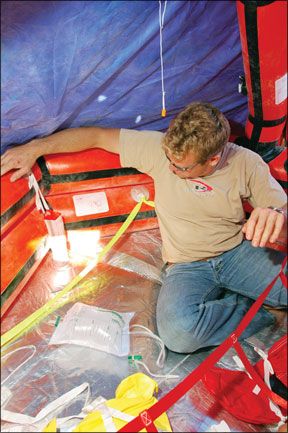
For our life raft test, we asked each maker to equip its raft for an offshore voyager planning a Caribbean cruise and possibly carrying on with a trans-Atlantic crossing.
It was no surprise that some packs were more complete than others. Two manufacturers, Winslow and Switlik, included separate ditch bags with the rafts they sent, and the contents were specifically chosen to supplement what was packed on their respective rafts.
The hierarchy of life raft survival packs ranges from a basic emergency kit (E-type) that the manufacturer puts together to the internationally standardized Safety of Life at Sea (SOLAS) A-package, which is more comprehensive and nearly twice as heavy as the E-type kits. The International Sailing Federation (ISAF) and the International Organization for Standardization (ISO) have their own guidelines for what should be included in the packs, and these kits tend to be less comprehensive than commercial-grade SOLAS A (offshore) and B (coastal) survival packs.
In our view, none of these standardized packages is ideal. (No raft contained a proper radar reflector, a glaring omission in our view.) Even those sailors who have a customized life raft survival kit should be prepared to pack additional gear and supplies in an overboard bag. We will be looking more closely at ditch kits and their contents in a future issue.

The contents of all life raft survival packs can be divided into three categories: vessel gear, crew aids, and signaling equipment. Vessel gear includes items like paddles, a heaving device, a bailer and a drogue&emdash;equipment that helps in recovering crew, getting away from a sinking or burning vessel, and keeping the life raft afloat.
Among the vessel gear, we found patching gadgets and material. Some were ultimately useful, and others came with directions that instructed users to “make sure both surfaces are completely dry before applying cement”&emdash;not the most realistic expectation.
The essentials packed for crew well-being included seasickness medication, sunblock, and reflective coveralls that help conserve body heat&emdash;similar to emergency “space blankets.”
The most obvious difference among the packs was the amount of drinking water. The Elliot 6-SOLAS had the most water (about 2.38 gallons), while two of our recommended rafts, the DSB 6-ISAF and the Switlik SAR-6 MKII, had none. Anyone who owns a life raft must know how much water it contains and have a plan to augment that supply.
The more diverse your distress signaling ability, the greater your chance of rescue. All of the rafts we tested provided flares, flashlights, and mirrors, but these items are fairly crude compared to what is available today. In the last decade, call-for-help technology has grown more reliable and smaller in size. The introduction of EPIRBs and their smaller cousins, the 406MHz Personal Locator Beacons (PLB), allow a person to summon a rescue coordination center (RCC) with the push of a button&emdash;although a timely response is by no means guaranteed, particularly in remote parts of the world. When you include a portable satellite phone, a cost-effective, 121.5MHz handheld, aviation VHF transceiver for contacting planes overhead, and a handheld VHF, a life raft seems more like a floating phone booth with 911 on speed dial.
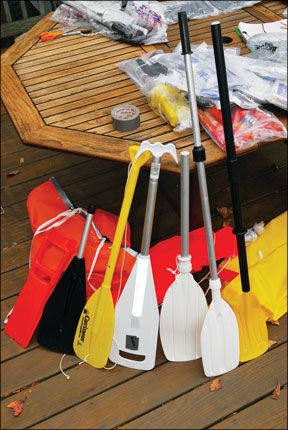
None of the rafts we tested, however, came with an EPIRB, SART (search and rescue transponder), or VHF onboard. Winslow provided an EPIRB in its superb abandon ship kit, but we look forward to the day when EPIRBs are built into the raft. The technology is currently available (U.S. Marines carry satellite-linked PDAs into battle), but putting electronics in wet, harsh conditions takes some serious consideration.
The most common approach today is to include EPIRBs and similar equipment in an abandon ship kit, but it would be even better if this signaling was as automated as the inflation of the raft itself. The night-time drills held during raft testing convinced testers that in the chaos of an emergency, it is easy to overlook the EPIRB or to fail to bring along a handheld sat-phone kept ready at the nav station.
A life raft that comes equipped with an EPIRB and a comprehensive survival pack will, of course, be heavier and more difficult to stow and launch. Another school of thought emphasizes the importance of keeping the raft light and easy to launch by putting most of the survival equipment in a separate abandon-ship bag. Both arguments have merit, and perhaps a blend of the two philosophies offers the best solution. A belts-and-braces approach would place an EPIRB (and, if the budget allows, a sat-phone) on the boat where its ready for evacuation, and another EPIRB on the life raft itself. If a single EPIRB is the only option, it belongs on the boat in a dedicated location where it is handy during evacuation.
If a sat-phone is used as part of the normal high-seas communications routine, its operation will become second nature, a big advantage in an emergency. The trick is to stow the unit in a grab case thats waterproof and ready to go, and the phone manufacturers offer such options. In fact, all communication gear such as radios and sat-phones should be kept in a truly waterproof container with extra batteries, sealed separately. The package should also include a list of phone numbers to reach the U.S. Coast Guard or, if voyaging overseas, the relevant RCCs. Its also important to assign crew ahead of time to essential roles such as the raft launcher, grab-bag steward, Mayday communicator, EPIRB and phone-in-a-box carrier, etc.
A survival situation rarely unfolds as it has been rehearsed. The longer you are on the raft, and the farther you are from a well-equipped RCC, shipping lanes and land, the more your survival depends on things beyond your control. Drinking water immediately enters the equation. Sailors in the Intertropical Convergence Zone (ITCZ) should find enough rainfall, but those elsewhere will face bleaker prospects for catching water. All too often, the rain comes with wind and sea and chop, and spray taints the fresh water running down the canopy into the catchment container. The solution is to bring extra drinking water aboard the life raft and to have a hand-pumped watermaker in the ditch kit.
In the raft
The E-pack is a basic kit found in many recreational life rafts, and its a good start to providing essential equipment for the raft and its crew. This kit is light, usually under 20 pounds, and compact&emdash;keeping the rafts bulk and weight to manageable proportions. However, the limited supplies mean that an abandon-ship bag is essential. Reviewing what we found in the rafts should help you get a feel for what else is needed to augment the supplies. The following are some of the testers comments regarding essential items found on the rafts. The table on page 14 compares the survival packs found in each raft.
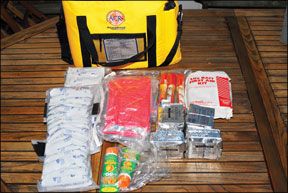
Not only is there a difference between brands of handheld and rocket-propelled flares, but theres also a wide gap between the standards for which they are designed. For example, when launched, a SOLAS-grade parachute flare burns longer and brighter than one designed simply to meet the U.S. Coast Guard requirements. Only the Elliot SOLAS raft included smoke canisters, a useful signalling device during daylight hours.
Using sunlight to gain the attention of nearby ships and aircraft can be effective. The large, highly polished stainless steel mirrors with center-hole targeting features made sense and proved easy to use. Each raft included at least one mirror in its onboard kit.
Flashlights
Any life raft flashlight should have a waterproof switch. Since the life raft kits usually contain no more than one set of extra batteries, youll want to know what size spares to pack in the abandon-ship bag.
When its time for a raft to be inspected, an owner should ask to be present when its inflated. This is a great opportunity to see firsthand whats offered in your survival kit.
Clamps are a great means of sealing a puncture and a big improvement over less expensive, screw-type plugs, which are quick to use but make for a less durable repair. Glue-on patch kits can be useful during a spell of hot, calm weather, but in windy, offshore conditions with high humidity and plenty of salt spray, prepping and drying the surface for bonding may be impossible.
Watermakers
Winslow included a hand-pump Katadyn Survivor 6 watermaker in its optional abandon-ship bag. The watermaker can make up to 6 gallons of water a day if continually pumped. This divides out to a quart an hour, and based on a 40-stroke per minute pump regimen, it takes about 9,600 strokes of the pump to make 1 gallon&emdash;a demanding commitment, even for those with time and energy to spare. Augmenting this device with Manta Ventures SeaPack (Chandlery, March 2007), a passive desalinization system that effortlessly converts seawater to a nutrient drink, might provide relief in bad weather when the crew is too sick or busy bailing to pump.
To anyone at sea in a life raft, a 406 EPIRB (preferably GPS-enabled) is worth its weight in gold. Winslow packed one in its grab bag, and the life raft arch tube had a built-in pocket to secure the device. Switlik also offered an EPIRB as an optional item in its grab bag. Sailors on rafts with foil floors should make sure that an activated EPIRB is kept away from the foil. Many EPIRB makers recommend that their unit be deployed in the water and securely tied to the raft. Determine ahead of time how your unit(s) will be used.
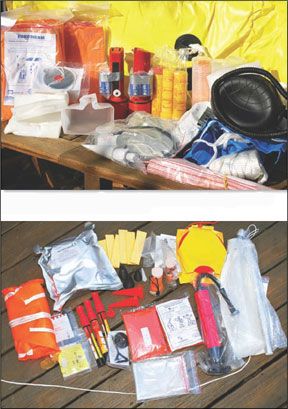
The brightly colored, positively buoyant abandon-ship bag should have a line on it that is secured to the life raft as soon as the bag goes aboard. Although raft space is limited, essentials such as eyeglasses, personal medications, the vessels first-aid kit, and passports (or photocopies of them) are worth taking along. Decide ahead of time on what should be in the ditch kit and keep it in a designated location thats easy to access.
Today, the life rafts primary mission is no longer to serve as a means of navigating to safety, but rather a platform from which to signal for help. Thats fine if you have the gear needed to make the maritime equivalent of a 911 call. The current approach to life raft survival equipment, however, often leaves the mariner with what amounts to two tin cans and some twine.
So if you are serious about survival, youll need to give some careful thought to augmenting your life raft with an abandon-ship kit that has an EPIRB. An onboard satellite phone is also an underestimated survival tool, one that can be used not only from the life raft, but also for medical emergencies. A plan to supplement the rafts water supply deserves equal attention.
The gear you have with you can mean the difference between life and death, and based on our research, none of these rafts come with the ideal built-in inventory. We strongly endorse a supplementary abandon-ship bag that manufacturers such as Switlik and Winslow provide at additional cost.
If we were to isolate three survival packs that stood above the rest, those found in the Winslow Ocean Rescue (the clear leader here), the Switlik MD-3, and the Elliot 6-SOLAS come the closest to meeting our expectations.
A raft and the survival gear it contains can be augmented by the extra gear taken aboard, but equally important are the skills and attitude of the crew.
- Practical Sailor Guide: Life Raft Survival Gear
- Safety & Survival
- Inflation Pumps
RELATED ARTICLES MORE FROM AUTHOR
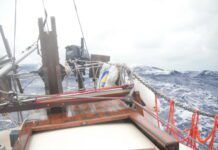
Responding to Emergencies: A Skipper’s Guide for Staying Calm

Sailboat Safety on Deck

Master the Sailing Basics: Never Stop Learning the Little Things
Good Day My name is Charles Merritt and I will like to order life. Kindly email back with the cost of Revere Coastal Elite Life Raft and we can proceed from there. Thank you
LEAVE A REPLY Cancel reply
Log in to leave a comment
Latest Videos

The Perfect Family Sailboat! Hunter 27-2 – Boat Review

Pettit EZ-Poxy – How to Paint a Boat

The Boat From True Spirit – Sparkman & Stephens

Top 5 Boat Hacks – Boat Maintenance Tips and Tricks
Latest sailboat review.

- Privacy Policy
- Do Not Sell My Personal Information
- Online Account Activation
- Privacy Manager
Experts puzzle over why Bayesian yacht sank. Was it a 'black swan event'?

The Bayesian set off on a leisurely cruise around Italy's southern coast on a sunny day in late July.
The luxurious super yacht − which boasted one of the largest masts in the world and carried a crew of business moguls, including British tech tycoon Mike Lynch and his family and a chair of Morgan Stanley − set sail from the Amalfi Coast, bound for Sicily.
Less than a month later, the ship had sunk 160 feet under the water , leaving its cook dead and six of its passengers, including at least two Americans, missing and prompting a massive search that has drawn international attention.
Now, experts are trying to piece together why in the early hours Monday the Bayesian was quickly pulled under the waves amid a storm that saw at least one tornado spin up over the water.
Breaking news to start your day smart. Sign up for USA TODAY's Daily Briefing newsletter.
A perfect storm led to Bayesian sinking, experts say
The combination of unlikely factors that could have contributed to the ship's fate constituted a "black swan event," Matthew Schanck, chairman of the Maritime Search and Rescue Council, told USA TODAY.
The Bayesian was well-built: A 2008 product of Italian ship maker Perini, it was constructed in accordance with international maritime standards and commercially certified by the U.K.'s Maritime and Coastguard Agency, according to Schanck.
The bout of bad weather that swept the area when the ship went down was also out of the ordinary in the northern Mediterranean, "which isn't renowned for prolonged, significant stormy weather," he said.
"The fact that those two elements have then resulted in the foundering of a super yacht is pretty extraordinary," Schanck said. "These things don't happen every day."
After the ship sank just before 5 a.m. local time, 15 people, including a 1-year-old, were pulled from the water. Some were rescued from a life raft by the crew of a ship docked nearby.
Ricardo Thomas, the ship's cook and a native of Antigua, was found dead, according to authorities.
As of Tuesday, six people were missing, including Lynch and his 18-year-old daughter. Several missing passengers were involved in Lynch's trial on fraud charges, including Jonathan Bloomer, a Morgan Stanley chair who served as his character witness, and one of Lynch's attorneys. Lynch, accused of fraud after he sold his company to electronics giant Hewlett-Packard, was acquitted of all charges weeks ago.
Who is Mike Lynch? UK entrepreneur among those missing after superyacht sinks off Sicily
Tornado formed over unusually hot water
Storms in the area that night may have whipped up a water spout, a tornado over the water , according to local meteorologists.
It was likely triggered by the water's unusual warmth, said Rick Shema, a certified consulting meteorologist who served in the Navy.
"The water spout was an uncommon occurrence," he said. "But again, these things happen, especially in warmer water."
At 83.7 degrees, water in the area was more than 3 degrees hotter than average on the day the Bayesian sank, likely the result of climate change, Shema said.
"Hurricanes can form at 80 degrees. This was almost four degrees higher than that," he said.
The water spout may have spun up when cooler air dropped from mountainous places nearby onto the hot water, he said. "A water spout is a vortex, basically like a tornado, spinning real fast, sucking up water and moisture as the column rises," he said.
Although water spouts only reach around 120 mph, as compared with tornadoes on land, which can reach up to 300 mph, "you don't need 200 mph to sink a ship," he said.
"Even an average tornado, 120 miles an hour, that's a lot of wind," he said, "which would heel the boat over for sure."
Water spouts spring up suddenly, Shema said. Before they strike, winds can be slow, but "once the water spout comes over, bam, it's on," he said.
Before sunrise, the ship's crew may not have seen the water spout coming. "The visibility was probably a big factor," he said.
With the windows of the yacht opened, as they likely were in the hot weather, the water spout could have triggered water that flooded through the portholes, Shema said, causing the ship to sink.
Tragedy strikes: Scramble to find survivors after Bayesian yacht sinks off Sicily coast
Search continues, but shift to recovery phase approaches
Italian authorities said the Bayesian was probably at anchor when the storm struck, meaning it couldn't maneuver and ride the waves, according to Mitchell Stoller, a captain and maritime expert witness. Other ships in the area that turned on their engines rode out the storm, he said.
"When you're at anchor and you see weather, you start your engine and you put the wind on the bow. You don't let it get on the side," he said.
Schanck said another key question concerns the position of the keel, a heavy weight underneath the boat that acts as a counterbalance to keep it upright, when the ship sank. When lifted, "that's going to affect the stability of the vessel, because, obviously, you've now raised the center of gravity of that vessel," he said.
The Bayesian was floating over 160 feet of water at the time, deep enough that the keel would likely be deployed. But the fact that "the vessel heeled over so heavily makes me question that," Schanck said.
The cause of the disaster may not be known until the ship can be examined in more detail, experts say. Prosecutors in a nearby town have already opened an investigation.
Schanck said investigators will have plenty to work with once the operation moves into a recovery phase.
"The vessel is intact and in good condition on the seabed," he said. "There's a lot of eyewitness accounts from other vessels in the area and the shore."
As the search entered its second day on Tuesday, the rescue effort may shift in that direction soon. "I suspect, later on, today or tomorrow, we'll probably see some mention of a recovery operation being stated," Schanck said.
The decision to would depend on whether rescuers find signs of life in the ship and air pockets or survivable spaces, Schanck said. At this point, survivors on the water's surface looks unlikely. "My professional opinion is that the casualties will be located within the vessel," he said.
"There is a risk versus benefit in all maritime search and rescue incidents," he said. "Where we start transitioning to a recovery phase, that line shifts."
Contributing: Reuters
Cybele Mayes-Osterman is a breaking news reporter for USA Today. Reach her on email at [email protected]. Follow her on X @CybeleMO.

Service Locator
- Angler Endorsement
- Boat Towing Coverage
- Mechanical Breakdown
- Insurance Requirements in Mexico
- Agreed Hull Value
- Actual Cash Value
- Liability Only
- Insurance Payment Options
- Claims Information
- Towing Service Agreement
- Membership Plans
- Boat Show Tickets
- BoatUS Boats For Sale
- Membership Payment Options
- Consumer Affairs
- Boat Documentation Requirements
- Installation Instructions
- Shipping & Handling Information
- Contact Boat Lettering
- End User Agreement
- Frequently Asked Questions
- Vessel Documentation
- BoatUS Foundation
- Government Affairs
- Powercruisers
- Buying & Selling Advice
- Maintenance
- Tow Vehicles
- Make & Create
- Makeovers & Refitting
- Accessories
- Electronics
- Skills, Tips, Tools
- Spring Preparation
- Winterization
- Boaters’ Rights
- Environment & Clean Water
- Boat Safety
- Navigational Hazards
- Personal Safety
- Batteries & Onboard Power
- Motors, Engines, Propulsion
- Books & Movies
- Cockpit Confessions
- Communication & Etiquette
- Contests & Sweepstakes
- Colleges & Tech Schools
- Food, Drink, Entertainment
- New To Boating
- Travel & Destinations
- Watersports
- Anchors & Anchoring
- Boat Handling
- ← Safety & Prevention
Advertisement

The BoatUS Safety Foundation tested eight different life rafts in 1991, all of which performed as advertised. Excerpts of their findings, Foundation Findings Report #12, Survival Rafts, are reprinted here to help you choose which raft is right for you. (Complete reprints of the article are available by contacting the BoatUS Safety Foundation.) To make a selection, assess your risks and your probability of rescue within a given time, based on the type of boating you do and the location-whether you're near shipping lanes or popular fishing spots near shore, or you're planning a cruise to some of the more isolated parts of the world. Consider the features outlined below in making your decision.
Basic Types of Rafts
There are three basic life raft designs: coastal, offshore, and ocean-going. Platforms are designed to keep survivors out of the water while they await a quick rescue. Coastal rafts should only be considered if there is a high probability of rescue within a day, because they lack features needed for long-term survival, such as double inflation tubes. Offshore rafts extend survival time to four or five days by including supported canopies and two buoyancy tubes (the second tube acts as an emergency backup). Ocean-going rafts are designed for long-term survival of at least 30 days, and are required equipment on most commercial vessels and by some international racing authorities.
What to Look for in a Life Raft
Below is an outline of the basic features to consider, with notes from our tests.
SOLAS-Approved Rafts vs. Other Rafts
When purchasing a product that will be used to keep you alive in an emergency, it only makes sense to get one that meets that highest standards available for comparison. SOLAS standards are very strict, as they are with all SOLAS-approved gear. SOLAS standards require that approved rafts have a boarding platform, additional safety gear, and considerably more interior space than commercial-grade models.
Most flat-bottomed survival rafts use a combination of water-filled ballast pockets and a cone-shaped sea anchor on a long (60' or more) line to prevent capsizing. The filled pockets resist the lifting action of wind and waves, and the anchor adds drag to keep the raft edge down. Toroidal-shaped and hemispheric ballast systems have proven most effective in preventing heavy-weather capsize. Bags with large holes for rapid filling also help keep the raft from blowing over before passengers can board.
The sea anchor is an integral part of the stability design. It creates drag, prevents "riding", reduces the chances of capsizing, and turns the raft's hatch away from oncoming waves. Buoyancy Tubes Life rafts come with either one or two automatically inflating buoyancy tubes. Short-term survival coastal rafts have one tube with two air chambers to prevent complete deflation in the event of a puncture. Double-tubed rafts found on all offshore and ocean-going rafts increase freeboard and reduce the likelihood of swamping. The second tube should support two-thirds of the raft's rated capacity when the largest buoyancy chamber is completely deflated.
When secured to your boat, the painter keeps the raft from floating away, and when pulled, it activates the inflation mechanism. More than one pull is usually needed to activate inflation, because there is between 15-55' of slack to take in. Many painters have a colored marker indicating that the next pull will activate the carbon dioxide (CO2) cartridge to inflate the raft.
Manual Inflation
Temperature changes cause raft air pressure to fluctuate. When hot, the tubes expand and excess air pressure is released through the over-inflation valves. When cool, the tubes contract and will require topping off. Three types of manual pumps are available: an oral inflation tube, which is next to impossible to use effectively; a foot pump which doesn't work well on the inflated rubber floor; and an accordion-like hand pump that is, by far, the easiest to use.
Although canopies shield survivors from sun, wind, and water, they can leave crowded passengers feeling claustrophobic and sick because of the reduced view of the horizon and, in some cases, a notorious rubber interior smell. Canopies with large entryways, port holes, and separately furled panels offer greater horizon views and increased ventilation. Double doors increase ventilation and light and make it easier to keep watch. Dark-lined interiors, like blue, are easier on the eyes; they diminish the sun's glare on a bright orange canopy. Canopies are supported by arches that keep the raft from inflating upside down and allow occupants greater interior room. Some arches are independent of the buoyancy tube and require manual inflation once occupants board. These rafts run a greater risk of inflating upside down but are easier to board from the mothership.
Storage Containers
Rafts come in either a soft, flexible valise for below-deck storage, or a durable fiberglass canister for mounting on deck. Canisters are usually bigger, heavier, and more expensive than valise containers. However, they can be mounted right on deck, and will withstand the elements. The fabric valise may be lashed on deck for trips, but won't last topside in the long run. Also, be sure to secure it carefully, since it won't do you any good if it goes overboard. Carefully choose the most accessible and convenient location on your boat-account for raft weight and size. A life raft is useless if you can't get to it and safely launch it when you need it. Remember, anyone on board may have to carry it topside, and valuable minutes will be wasted if you have to pull it out of a cluttered locker.
Rafts have either single or double-layer floors. Double floors insulate passengers from energy- draining cold water, reduce the feeling of sitting on a half-filled water bed by keeping the floor from swallowing your feet and legs, and help to eliminate the bumps and bruises from curious marine life. Certain designs secure the additional floor with button-like fasteners that create depressions in the raft floor and allow water to collect. Some floors keep passengers drier using a highly porous material to trap splashed water.
Capacity Ratings
These ratings specify the maximum number of people a raft will hold, based on a minimum of approximately four square feet per person. They do not consider comfort, space needed to perform raft maintenance and repair work, or room to store extra survival gear. If you plan to carry the maximum number on board, you had better hope for a quick rescue.
How to Reduce Life Raft Costs
Rafts should be serviced annually by certified technicians to ensure proper performance. Like your car, if you follow the recommended service schedule, you'll pay less than if you wait until something breaks. Fees range for annual inspections, depending on raft size, type and gear replaced. The third and fifth years will cost $200-350 due to extra service needs. Always go to a reputable servicer-one of our staffers told of an unfortunate skipper whose raft canister was filled with sand instead of his serviced raft. This isn't a place to cut corners! A reputable servicer will show you a certificate of mfr.'s approval and will let you watch them service your raft. If they can't, take your raft somewhere else.
Coast Guard Requirements
Recreational boaters are not required by the Coast Guard to carry an approved life raft. Certain commercial vessels are required to carry an approved raft. Inspected vessels receive an inspection certificate which specifies what they must carry. Requirements for uninspected vessels vary.
Related Articles
The truth about ceramic coatings for boats.
Our editor investigates the marketing claims of consumer-grade ceramic coatings.
Fine-Tune Your Side Scan Fishfinder
Take your side-scanning fishfinder off auto mode, and you’ll be spotting your prey from afar in no time
DIY Boat Foam Decking
Closed-cell foam flooring helps make boating more comfortable. Here’s how to install it on your vessel
Click to explore related articles
BoatUS Editors
Contributor, BoatUS Magazine
Award-winning BoatUS Magazine is the official publication of Boat Owners Association of The United States. The magazine provides boating skills, DIY maintenance, safety, news and more from top experts.
BoatUS Magazine Is A Benefit Of BoatUS Membership
Membership Benefits Include:
Subscription to the print version of BoatUS Magazine
4% back on purchases from West Marine stores or online at WestMarine.com
Discounts on fuel, transient slips, repairs and more at over 1,200 businesses
Deals on cruises, charters, car rentals, hotel stays and more…
All for only $25/year!
We use cookies to enhance your visit to our website and to improve your experience. By continuing to use our website, you’re agreeing to our cookie policy.
Here's what we know about why a luxury sailing boat sank off the coast of Sicily

Emergency workers in southern Italy are still hunting for six people missing after a tornado sank a luxury yacht early Monday - prompting an air and naval operation off the coast of Sicily.
Fifteen people were rescued from the wreckage, according to Italy's Coast Guard. One body was recovered on Monday and four more on Wednesday, after divers struggled to reach deep inside the yacht around 50 meters underwater (approximately 150 feet).
Two Americans and four Britons were among the six initially reported missing - including British tech tycoon Mike Lynch, Jonathan Bloomer, chairman of Morgan Stanley International, and Chris Morvillo, a prominent lawyer.
Here's what we know.
What happened?
A small waterspout - a type of tornado - spun over the Mediterranean island early Monday, likely capsizing the sailing boat amid lashings of rain and strong thunderstorms.
The British-flagged yacht, called the "Bayesian," was anchored about a half a mile from the port of Porticello, on Sicily's northern coast. The vessel sank after its mast broke in half in the storm, Salvatore Cocina, head of Sicily's Civil Protection, told CNN on Tuesday.
Eyewitnesses described furious gales and hurricane-like winds that left an avalanche of debris near the pier.
More than a dozen survivors were spotted in the area hanging onto life rafts, according to the captain of a nearby boat, who steadied his ship to avoid colliding with the Bayesian.
"We got this strong hurricane gust and we had to start the engine to keep the ship in an angled position," Karsten Bower told reporters in Palermo on Monday. "After the storm was over, we noticed that the ship behind us was gone."
Bower and his crew rescued four injured people, he said, before calling Italy's Coast Guard - who later rescued the remaining survivors.
One of those rescued - a child - was airlifted to the children's hospital in Palermo. Eight people were hospitalized in total, according to the mayor's office.
The girl's mother, Charlotte, described how she battled to hold onto Sofia, her 1-year-old daughter, as reported by Italian news agency ANSA.
"In two seconds I lost the baby in the sea, then I immediately hugged her again amidst the fury of the waves. I held her tightly, close to me, while the sea was stormy," she told journalists. "Many were screaming."
The mother and daughter were later reunited with the father, James, according to a doctor at the local children's hospital in Palermo.
"The survivors are very tired and are constantly asking about the missing people," the doctor, Domenico Cipolla, said Monday. "They are talking and crying all the time because they have realized that there is little hope of finding their friends alive."
Italy's fire brigade dispatched helicopters to aid in the search, officials said Monday. After an unsuccessful attempt on Monday, the brigade sent divers to try and enter the sunken ship Tuesday, recommencing the operation on Wednesday.
The depth of the wreck means divers can only work there for limited periods of time, according to Marco Tilotta, an inspector for the diving unit of Palermo's local fire brigade. The Italian fire brigade said Monday its divers had reached the yacht's hull 49 meters (160 feet) below sea level.
The United Kingdom's Marine Accident Investigation Branch (MAIB) said it has deployed a team of four inspectors to Palermo which is conducting a preliminary assessment of the scene.
Who was on board?
Twenty-two people were on board the Bayesian, which was flying under a British flag and had mostly British passengers and crew, in addition to two Anglo-French, one Irish and one Sri Lankan person, a spokesperson for Italy's Coast Guard told CNN.
A troupe of high-profile guests are among those missing, including Lynch, the 59-year-old British tech investor who fought a fraud case earlier this year in the United States - which spiraled from the disastrous $11 billion sale of his company to tech firm Hewlett-Packard (HP) in 2011.
His 18-year-old daughter was also named missing. Lynch's wife, Angela Bacares, survived the accident. Bacares told Italian daily newspaper La Repubblica that she woke up at 4 a.m. local time, as the boat tilted. She and her husband were not initially concerned, she said, but became worried when the windows of the yacht shattered and chaos erupted.
RELATED: Divers find 4 bodies during search of superyacht wreckage after it sank off Sicily, 2 still missing
Bacares spoke to the newspaper while sitting in a wheelchair, at a hospital in the Sicilian town of Termini Imerese. She had abrasions on her feet and bandages on other parts of her body, it reported.
Bloomer, the finance tycoon, and Morvillo, a prominent lawyer - and both their wives - are also among the missing, according to Salvatore Cocina, head of Sicily's Civil Protection.
Morvillo, an American partner at Clifford Chance, was involved in successfully defeating the US fraud case against Lynch in June. Another employee of the firm, Ayla Ronald, and her partner, survived the incident, according to a spokesperson for Clifford Chance.
The body that was recovered from the vessel on Monday was identified as the onboard chef Ricardo Thomas, an Antiguan citizen, Reuters reported.
What do we know about the boat?
Built in 2008, the 56-meter (184-foot) yacht was manufactured by Italian company Perini Navi, Reuters reported. According to the Associated Press, the boat has been available for charter for $215,000 (195,000) per week.
Lynch's wife is linked to the yacht. The Bayesian is held by the company Revtom Limited, according to records from the maritime information service Equasis. The company's latest annual return from April lists Bacares as the proprietor.
"Bayesian," the name given to the vessel, is linked to the statistical theory on which Lynch built his fortune, according to Reuters.
The yacht's mast stood 72.27 meters (237 feet) high above the designated water line, just short of the world's tallest mast which is 75.2 meters, according to Guinness World Records. It was the tallest aluminium mast in the world, the Perini Navi website said.
Perini Navi is known for making "good quality boats," according to Caroline White, deputy editor of BOAT International, a media group serving the superyacht industry.
White told CNN that if the Bayesian dismasted, "it should theoretically become more stable." "But it might be a different story if you are in the middle of a violent storm with incredibly strong winds pinning you to the water," she added.
Dangerous weather conditions
Strong storms across Sicily brought torrential rainfall late Sunday. Initial reports suggest a small waterspout, which developed over the area Monday morning, could have been behind the yacht's sinking.
Waterspouts - one of several types of tornadoes - are spinning columns of air that form over water, or move from land out to water. They are often accompanied by high winds, high seas, hail and dangerous lightning. While they are most common over tropical oceans, they can form almost anywhere.
Matthew Schanck, chair of the Maritime Search and Rescue Council, told CNN that while waterspouts in Sicily are rare, "there is a risk" they can happen - just not every day.
Waterspouts rely on warm waters to gain energy and the Mediterranean Sea has been very hot, reaching a record daily median of 28.9 degrees Celsius (84 Fahrenheit) last week, according to preliminary data from researchers at the Institute of Marine Sciences in Spain.
Local temperatures have been even higher, with waters around Sicily reaching almost 30 degrees Celsius (86 Fahrenheit), almost 3 degrees more than normal, Italian climatologist Luca Mercalli told CNN.
"Warmer oceans have more energy and more humidity to transfer to the atmosphere, the most important fuels for storms," he said.
(The-CNN-Wire & 2024 Cable News Network, Inc., a Time Warner Company. All rights reserved.)
Related Topics
- BOAT ACCIDENT
- U.S. & WORLD
Top Stories

Missing 8-year-old boy with autism found dead in lake, FBCSO says

After mostly dry weekend, multiple rain opportunities in the forecast
- 2 hours ago

Israel and Hezbollah trade heavy fire

1 dead, 3 wanted in fatal Houston parking lot shooting, police say
- 43 minutes ago

More charges emerge against woman accused of illegal butt injections
Texans hold off Rams for preseason finale win
FM1960 reopen after fatal bicycle crash, HCSO says
Man killed after off-duty deputy slams into his vehicle: Officials
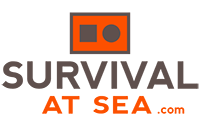
- USCG/SOLAS Liferafts
- USCG Coastal Liferafts
- Inflatable Buoyant Apparatus (IBA)
- Commercial Liferaft Accessories
- Recreational Liferaft Accessories
- Aviation Liferafts
- In-Stock Liferafts
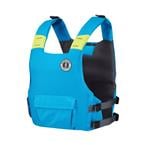
- Foam Type I, Type II, Type III
- Youth/Child/Infant Life Jackets
- Pet Flotation
- Float Coats
- Life Jacket Accessories
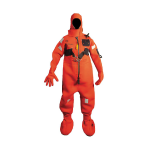
- USCG Approved
- USCG/SOLAS/TC Approved
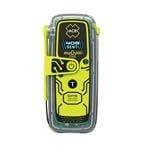
- AIS (Automatic Identification System)
- Local / Bluetooth
- Satellite Phones
- Satellite Messengers
- Lights & Strobes
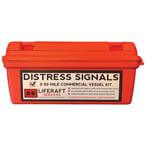
- Pyrotechnic
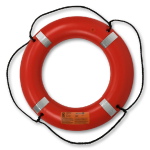
- Life Rings & Type IV Throwables
- Life Slings
- MOB Recovery Devices
- Marine First Aid Kits and Supplies
- Prep & Survival Accessories
- Active Wear
- Waterproof Boating Bags and Storage Packs
- Accessories
- Inflatable Boat Repair Kits (DIY)
- BOATING FIRE EXTINGUISHERS
- Ditch Bag Packages (Abandon Ship Kits)
- Ditch Bag Electronics
- Ditch Bag Signaling
- Ditch Bag Rations & First Aid
- Ditch Bag Accessories
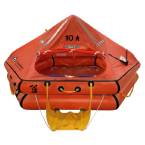
- Liferaft Sale
- Life Jacket Sale
- Signal Flare Sale
- Survival Suit Sale
- Apparel Sale
- Manufacturer Rebates
- Coupon Codes
- Pre-Owned Liferafts
- Gifts Under $100
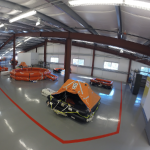
- EPIRB & PLB Battery Replacement Service
- Liferaft Inspection & Repack
- Immersion & Ice Suit Inspection
- Inflatable PFD Inspection
- Inflatable Boat Repair
- Partner Locations

- Commercial Liferafts
- ISO Approved Liferafts
Recreational Liferafts
- Valise vs. Container
- Emergency Pack Essentials
- Liferaft Servicing
- Life Jacket Fitting Guide
- Flares & Signaling Devices
- Commercial Fishing Regulations
- Life Raft Buyer's Guide
FREE Shipping over $149 (excludes liferafts, flares & oversize items)

Find Your New Liferaft:
Approved by the United States Coast Guard and The International Convention for the Safety of Life at Sea
- Available to Order
- Out of Stock
- Commercial Fishing
- Sailing / Yachting
- Passenger Vessel / Charter
- Survitec Survival Products
- Survitec Zodiac
- Low Profile Container (LPC)
- Out to 50 Miles (Commercial)
- Beyond 50 Miles (Commercial)
- 50 miles - SOLAS B
- Beyond 50 miles - SOLAS A
USCG/SOLAS life rafts are approved by both the United States Coast Guard and the International Convention for the Safety of Life at Sea (SOLAS). The equipment pack in these rafts can come in either a SOLAS A or SOLAS B configuration.
Marine Safety Resource Center
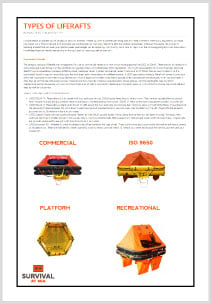
Emergency Beacons
Sign up for Special Offers and our Boating Safety Newsletter

Customer Service
- Order Status
- Gift Certificates
- Price Guarantee
- Terms and Conditions
Service Department
- Liferaft Inspection & Repack Request
- Immersion & Ice Suit Inspection Request
- Inflatable PFD Inspection Request
Simple & Secure Payment
Connect Wallet
select a wallet below
Sign up for Universal Rewards
Use your Loyal Points where you shop.
- Log in/Log out (Opens in new window)
- All content
- Rural Alaska
- Crime & Courts
- Alaska Legislature
- ADN Politics Podcast
- National Opinions
- Letters to the Editor
- Nation/World
- Film and TV
- Outdoors/Adventure
- High School Sports
- UAA Athletics
- National Sports
- Food and Drink
- Visual Stories
- Alaska Journal of Commerce (Opens in new window)
- The Arctic Sounder
- The Bristol Bay Times
- Today's Paper (Opens in new window)
- Legal Notices (Opens in new window)
- Peak 2 Peak Events (Opens in new window)
- Educator of the Year (Opens in new window)
- Celebrating Nurses (Opens in new window)
- Top 40 Under 40 (Opens in new window)
- Alaska Spelling Bee (Opens in new window)
- Alaska Craft Brew Festival
- Best of Alaska
- Spring Career Fair (Opens in new window)
- Achievement in Business
- Youth Summit Awards
- Teacher of the Month
- 2024 Alaska Summer Camps Guide (Opens in new window)
- Holiday Bazaar Guide (Opens in new window)
- 2024 Back to School (Opens in new window)
- Alaska Visitors Guide 2024 (Opens in new window)
- Bear Paw Festival 2024 (Opens in new window)
- 2023 Best of Alaska (Opens in new window)
- Alaska Health Care (Opens in new window)
- On the Move AK (Opens in new window)
- Senior Living in Alaska (Opens in new window)
- Youth Summit Awards (Opens in new window)
- Alaska Visitors Guide
- ADN Store (Opens in new window)
- Classifieds (Opens in new window)
- Jobs (Opens in new window)
- Place an Ad (Opens in new window)
- Customer Service
- Sponsored Content
Search efforts end for wreckage of boat that sank with 4 onboard near Homer
Mary and David Maynard and their sons Colton, 11, and Brantley, 7. (Courtesy Christi Wells)
The Alaska Dive Search Rescue and Recovery Team this week stopped looking for the wreckage of a boat that sank near Homer earlier this month with four people aboard.
A family member of Mary and David Maynard and their two sons, 11-year-old Colton and 7-year-old Brantley, filed a presumptive death petition with the Homer court this week.
The family of four was on a 28-foot aluminum vessel with four other people when it began taking on water Aug. 3 roughly 16 miles west of the Homer Spit, officials from the U.S. Coast Guard have said. The boat was a recreational vessel, not a charter, said Cmdr. Mike Salerno, spokesman for the 17th Coast Guard District.
The Maynards were inside the ship when it began taking on water and the other four people were on the deck, Salerno said. There are indications that the boat may have sunk quickly, but it’s not clear what caused it to take on water and the Coast Guard did not launch an investigation, he said.
The other four people aboard made it onto a life raft and were rescued by a good Samaritan nearby, authorities said.
The Coast Guard and Alaska State Troopers searched an area of roughly 1,420 square miles over 31 hours before suspending the efforts, Salerno said.
The Alaska Dive Search Rescue and Recovery Team began search efforts to find the wreckage using sonar equipment, but they were hampered for several days by poor weather, the organization wrote on social media . The team searched for about 10 hours last week, but winds, waves and fast currents made it challenging for the boat to maintain course while towing the sonar equipment, they wrote.
On Wednesday, the team said it was ending active search efforts.
“It is with great sadness, we are ending the active search efforts for the Maynard Family. If something is located or possibly located in the future we will respond to assess what is located if requested by DPS,” they wrote online. “Our thoughts and prayers continue to be with the survivors, their family, friends, and community.”
Mary and David Maynard were from Troy, Texas, and raised their sons there, their relative Christi Wells has said. Colton and Brantley both played soccer and baseball, she said.
Mary Maynard, 37, worked as a traveling nurse and David Maynard, 42, stayed home with their children and had a lawn care business. The family loved to travel and spend time with family and friends, which is what they were doing while visiting Alaska, Wells said.
On Friday, Wells said the family wants to thank the community and everyone involved in the search efforts for their support and prayers, she said.
Tess Williams
Tess Williams is a reporter focusing on breaking news and public safety. Before joining the ADN in 2019, she was a reporter for the Grand Forks Herald in North Dakota. Contact her at [email protected].

IMAGES
COMMENTS
If you are a commercial boat looking for a marine life raft, you will want to look at IBA or Inflatable Buoyant Apparatus Rafts. These rafts are specifically designed for commercial sailor and their vessel. Our selection of Inflatable Buoyant Apparatus rafts ranges from 4 man-size to 150 man-size, each with unique cradle and canister assemblies.
Shop Life Rafts for boaters and marine enthusiasts at Defender. Get fast delivery and free shipping on eligible orders over $99. ... Superior Life-Saving Equipment Universal Deck Mount Life Boat Cradle - CRD-SS-01 $462.99. 0. Revere ISO Universal Life Raft Cradle - 45-OSISOCRAD
Specifications: Cannister 4, 6 or 8 man. Weighs 28kg. Fully tested to the ISO 9650-1 Group A specs, the Waypoint ISO 9650-1 Ocean Elite liferaft is extremely well built and designed for the toughest sea conditions. This is one of the best liferafts in the market today for the ocean sailor.
Revere Supply's Coastal Compact Life Raft is a calm-water, inland solution, for four people, and is better than jumping in the drink with your life vest on. A sudden sinking or out-of-control fire would make you glad to have this platform. The raft weighs about 16 pounds, and most of that weight is in the inflating cylinder.
At least two separate flotation chambers. Insulated floors (two inflatable layers or with an insulating material) An inflatable canopy covering the entire raft. Large ballast bags suspended below the raft to stabilize it in high winds or waves. A boarding platform to make the raft easier to enter from the water.
These rafts are required aboard sailboats participating in certain offshore-racing events, and often such requirements trickle down to cruiser-based rallies, such as the Atlantic Rally for Cruisers, which now mandates a life raft meeting International Convention for the Safety of Life at Sea (SOLAS), ISAF, or ISO 9650 guidelines.
Life rafts are inflatable devices that are designed to provide flotation and environmental protection for a small number of persons for a short period of time. The life rafts that West Marine sells have capacities from 2-12 persons. Since boats can and occasionally do sink, boaters need ways to stay afloat until they can be rescued.
These Offshore recreational life rafts are a good option for any non-commercial boater or sailor who is travelling miles offshore and looking to stay safe in case of emergency. Some of these ISO-9650 life rafts also meet standards for some sailboat and yacht racing associations. Each of these offshore rafts include an offshore equipment pack ...
From $3295. Show Details. 1. 2. New life rafts from top brands like Crewsaver, Elliot, Zodiac, and Revere. Buy from the experts: We are USCG and manufacturer approved to service all of the liferafts we sell. Whether you're looking for a commercial liferaft for your fishing boat or passenger vessel, or an ISO approved or recreational liferaft ...
Call 1-800-838-3012 or visit Contact Us for other ways to connect. Winslow has a tradition of excellence for over seventy-five years. Winslow LifeRaft Company manufactures the finest marine and aviation liferafts. We combine superior quality and a wide array of standard features with unmatched performance.
Boats and davits Boats Davits Boats and davits accessories ... RAFT-35DK. Liferaft - VIKING, 6DK+, throw overboard (6 pers.), extended service interval. L006D027200NCA. Liferaft - VIKING, 8DK+, throw overboard (8 pers.), extended service interval. L008D027200NCA.
Stowing Cradle for 6-8-person Offshore Elite Life Rafts. Stowing Cradle for 4-Person Offshore Elite Life Raft. A life raft is one of the most crucial pieces of marine survival gear on your boat. With our wide variety of raft types it's easy to find the one you need whether you mostly cruise along the coast or are outfitting a commercial vessel.
Avalon Rafts — Wilmington 310-549-9665. Coast Marine — San Francisco 415-673-1923. Sal's Inflatable Services — Alameda 510-522-1824. Florida: Viking Life Saving Equipment — Miami 305-614-5800. Sun Coast Inflatables — Tampa 888-572-4317 (or) 727-572-4317. Lifeline Inflatable Services — North Miami 305-621-1500.
When selecting a life raft, it's essential to consider the number of people it needs to accommodate. Life rafts are available in various capacities, typically ranging from 4 to 12 persons. It's crucial to choose a life raft with a capacity that matches or exceeds the number of people on board your boat. Keep in mind that the stated capacity ...
Winslow LifeRaft Company is the world's leader for marine liferafts for the recreational boater and sailboat racer, built with only one thing in mind and that is to save your life. You operate the best equipment, and spare no maintenance, because safety is your number one priority. ... Deploying a Life Raft. Have a question? Call 1-800-838 ...
The rescue early this week of Alain Delord, the French single-hander whose boat was dismasted and holed Jan. 18 in the Southern Ocean, after he spent three days in a life raft offers a graphic reminder of the importance of choosing a raft that matches your voyage. ... Life raft survival kits used by the recreational yachting community can ...
Available To Order. From: $1725. Show Details. These coastal life rafts are a great option for the recreational boater or sailor who is staying within the perimeters of coastal waters closer to shore. Most of these life rafts are lighter weight and more compact, allowing more flexibility when it comes to storage of the raft on the vessel.
Our life raft test is carried out against the backdrop of relatively new marine safety standards. New criteria for life rafts for recreational boats have been established by the International Sailing Federation (ISAF) and the International Standards Organization (IS0). The Practical Sailor comparison features an in-depth look at eight life ...
A life raft is an integrated system in which the performance of individual features, or lack thereof, can significantly affect overall performance. ... it is more critical. A boat-shaped raft, running with wind and waves, is probably somewhat less likely to overturn, in this case end-over-end, than a comparably sized and ballasted round raft ...
Yachting & Aviation Life Rafts. Crewsaver Aviation Life Rafts; Revere Aviation Life Rafts; Switlik Aviation Life Rafts; Marine Life Rafts & Life Floats. Life Raft Accessories Supplies; ... Inflatable Boat Fuel Tanks; Inflatable Boat Emergency Repair Kits; Inflatable Boat Glue, Adhesives & Sealants; Inflatable Material PVC & Hypalon (CSM ...
Borner said he got into his boat's tender and saw a life raft with 15 people on it. Members of the crew were administering first aid. ...
Karsten Borner found the life raft with surviving passengers, revealing what him and his crew went through in the middle of the storm The valiant captain of a boat that helped to rescue 15 ...
Luckily the life raft opened up and 11 of us managed to get aboard." "It was terrible," she told ANSA. "In just a few minutes the boat was hit by a very strong wind, and sunk soon thereafter."
For Practical Sailors six-man life raft test, the examiners looked at eight life rafts suitable for a cruising sailboat with far horizons: the DSB 6-ISAF, the Elliot 6-SOLAS, the Switlik MD-3, the Switlik SAR-6 MKII, the Viking Rescyou, the Viking Rescyou Pro, the Winslow Ocean Rescue, the Zodiac Class Ocean ISAF.A close look at the survival gear that each life raft manufacturer provides ...
"Even an average tornado, 120 miles an hour, that's a lot of wind," he said, "which would heel the boat over for sure." Water spouts spring up suddenly, Shema said.
Life Rafts. The BoatUS Safety Foundation tested eight different life rafts in 1991, all of which performed as advertised. Excerpts of their findings, Foundation Findings Report #12, Survival Rafts, are reprinted here to help you choose which raft is right for you. (Complete reprints of the article are available by contacting the BoatUS Safety ...
More than a dozen survivors were spotted in the area hanging onto life rafts, according to the captain of a nearby boat, who steadied his ship to avoid colliding with the Bayesian. ... Perini Navi ...
Di 59-year-old bin dey on holiday for im boat wit family, members of im business and legal inner circle, wen di yatch bin sink afta one powerful storm strike am for Monday morning.
From $5994. Show Details. Crewsaver USCG/SOLAS Approved Commercial Liferaft. Available To Order. 1 review. From $3695. Show Details. USCG/SOLAS life rafts are approved by both the United States Coast Guard and the International Convention for the Safety of Life at Sea (SOLAS). The equipment pack in these rafts can come in either a SOLAS A or ...
The boat was a recreational vessel, not a charter, said Cmdr. Mike Salerno, spokesman for the 17th Coast Guard District. ... The other four people aboard made it onto a life raft and were rescued ...